








451 East Juanita Avenue, Suite 20, Mesa, AZ 85204

 BY MICHAEL GEYER
BY MICHAEL GEYER
It's not uncommon to hear that many people like to have that soft water feel while taking a shower or a bath. I don't blame them since many times the water coming from the tap can be very hard. That itchy, dry feeling after stepping out of the shower can be tough to bear every day. That soft water feel you get from a water softener would surely be great in your pool, too, right? Wrong. Unfortunately, soft water in pools is a bad idea due to the acidic nature of the water. Soft water systems remove the calcium from the water — and calcium is essential to keep your water balanced. This low-calcium environment can often cause the water to start eating the plaster right off the pool! Even salt water pools — often thought to be less harsh on our skin — produce liquid chlorine as a sanitizer and are not entirely free of chemicals. Thankfully, there is a much healthier way to get that soft water feel without compromising water balance or adding chlorine. Exceptional Water Systems offers one of the healthiest water treatment systems for pools and spas you can get. The Aqua Fuzion system takes pure ozone and diffuses it into the water. Ozone is one of the strongest natural sanitizers on the planet! It can be as much as 20 to 3,000 times stronger than chlorine and only leaves behind pure oxygen. That's right... no more nasty chemical byproducts left behind waiting to soak into your skin during your leisurely weekend by the pool.
Because Aqua Fuzion dissolves the ozone and oxygen into a solution it is able to stay in the water for extended periods of time. After the ozone has done its job of sanitizing and oxidizing contaminants in the water, it leaves behind billions upon billions of oxygen nanobubbles that leave the water crystal clear and feeling super soft!

To learn more about how we can help improve the water quality in your pool, give us a call at (480) 694-4709 or visit us at www.exwsystems.com. Exceptional Water Systems is dedicated to providing healthy water for humanity...no exceptions!

Utilizing natural elements to balance water.
time to recognize and celebrate the local businesses and leaders who are making a positive impact



our environment.
Nominate your favorite sustainable businesses and individuals who are leading the way towards a greener future. From innovative green technologies and sustainable shops to community and business leaders, we want to hear about the champions of sustainability in Arizona.
Why participate? By nominating and voting, you not only support your favorite eco-friendly establishments, you’ll be contributing to creating a cleaner and healthier Arizona for generations to come.












1 2 3
Know of a local business or individual leading the charge towards sustainability? Nominate them for a Best of Arizona Award!
Whether it’s an innovative eco-friendly product, a groundbreaking environmental project, or a dedicated champion of sustainable living, we want to hear about it. Help us shine a spotlight on these inspiring initiatives and the people driving change.
Starting September 13th, it’s time to cast your vote! Visit our website or scan the QR code below to access the official voting platform. Browse through the different categories and choose your favorites. Your voice matters, and your vote will determine the winners of the Best of Arizona Awards. Every vote counts in shaping our environmentally conscious future!
Join us in a memorable awards ceremony where we will applaud the winners and acknowledge their commitment to sustainability. By participating, you become an integral part of the sustainable movement, encouraging others to follow in their footsteps and make a positive impact on our planet.
Nominations end Sept. 8th | Voting ends Sept. 30th
www.greenlivingmag.com/best-of-az-2023
42
GOOD
14 A Gourmet Affair to Remember Arizona Restaurant Week kicks off September 8
16
Bill McKibben’s Third Act
Seniors find purpose in influencing environmental change in America
18 At Last! A Fully Sustainable Catering Company
Phoenix’s Atlasta Catering makes a positive impact
20 Farming Is Her Forte
The unexpected journey of St. Vincent de Paul’s director of urban farming
HEALTH & WELLNESS
24 Glow Up
Nosh on these nutritious foods for a more radiant appearance
SAVOR
40 Distill, My Heart
We’re crushing on Arizona’s local distillery scene
42 Home Grown
These local ingredients can be found on the state’s best menus

44 Recipes
The Italian Daughter’s Picchio Pacciu + Queen Creek Olive Mill’s Garlic Jam
TRAVEL
46 Agricultural Excellence
This Arizona resort is experimenting with its own unique variety of vegetables
TECHNOLOGY
50 From Poop to Power
Buckeye’s Butterfield Dairy produces renewable natural gas to power Arizona

Did you know that most mass-produced furniture contains harmful chemicals that can slowly make their way into your home exposing your family and pets to low-level long-term exposure?


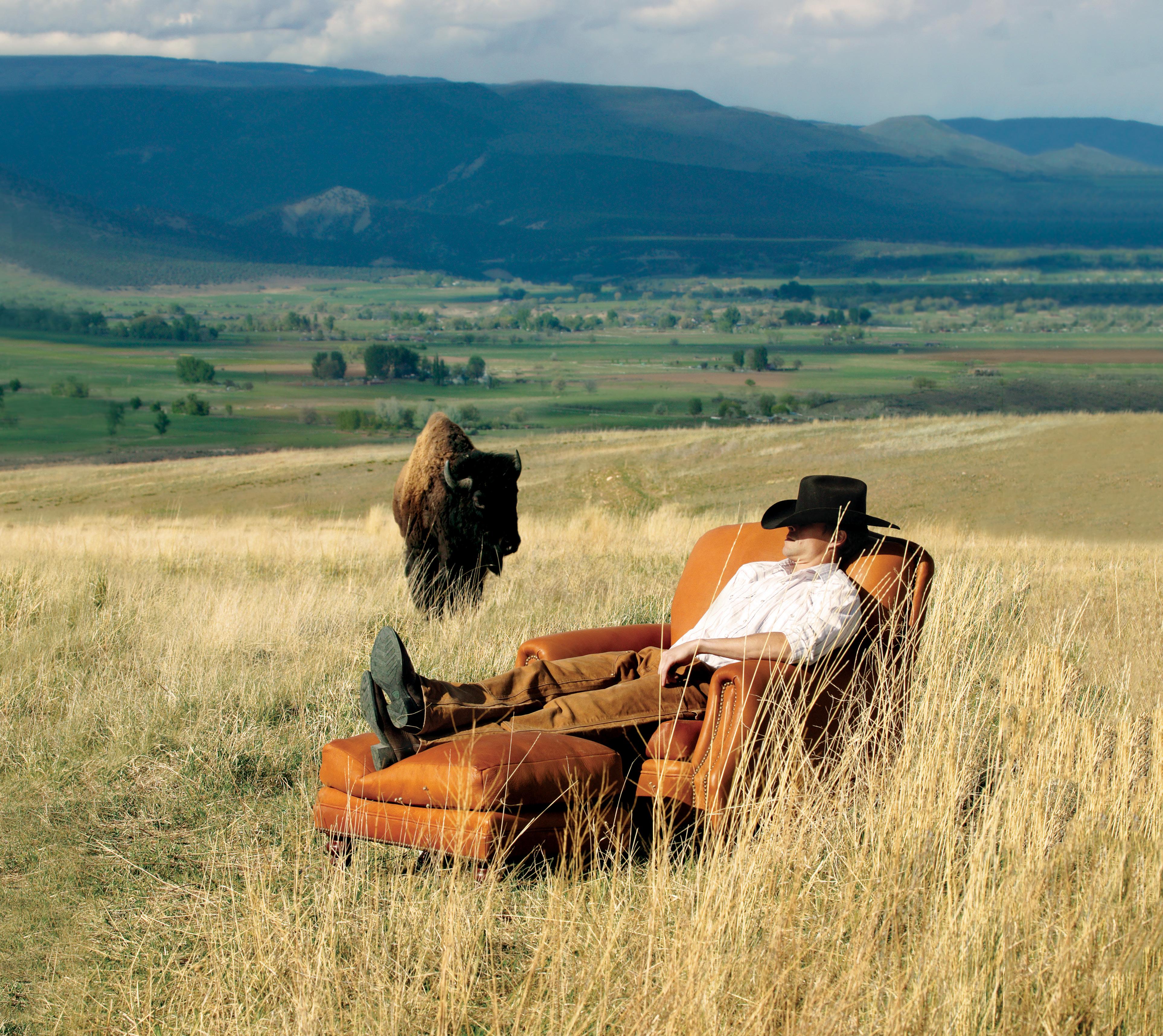
Our luxurious, heirloom quality buffalo leather furniture is handmade in America by skilled craftsmen using renewable materials and responsible tanning methods. Each piece is fully customizable, built to last, extremely durable, and made with clean, wholesome goodness. Just pure, simple furniture.

Dear Readers,

In a former life, I had the unique opportunity to work with some truly remarkable chefs — James Beard and Michelin Star winners, celebrity chefs — you get the gist. Having the ability to work around such talent on a regular basis not only developed my then-inexperienced palate, it also allowed me to nurture my own love for cooking and passion for food. Of course, I’m no professional chef by any stretch of the imagination, but there’s a distinct satisfaction and sense of joy that comes from creating something from scratch and watching as my family or friends light up with delight in response to what I’ve prepared for them. Cooking is also a great excuse to get my people together. Sure, we can enjoy a movie or occasional concert here and there — but there’s nothing like food to create the best memories that come from the collective enjoyment of a really good meal. Simply put, food brings people together.
Yet there’s more to a meal to think about than what it merely tastes like. Now, more than ever, it’s important for us to consider where our food comes from. When we dine out, are we choosing restaurants that make a point to support local suppliers to reduce their carbon footprint? Is the produce they use organic and are their meats humanely raised? How do we make healthier choices for ourselves and the planet?
In this issue, we’re not only celebrating food, we’re also highlighting the companies and individuals in the farming, restaurant, and hospitality industries working to reduce waste and create a positive impact on the earth. From our cover story on seacuterie (yes, you read that right), to local restaurants doing good by composting, Arizona-grown ingredients making their way to some of our state’s hottest menus, and so much more — foodophiles, gourmands, and food nerds unite! — behold Green Living’s food issue.
Mangia! , Shelby Tuttle Managing Editor
Alison Bailin Batz, better known as @ABSeesItAll online, is a veteran public relations executive who began freelance writing as a hobby in 2007. Today, she is a contributor on all things luxury travel, events, wine, food, and spirits for outlets across the Southwest. Alison’s aim in life is best summed up by her social handle as “AB” truly does want to “see it all” and share it all with you.

Misty Milioto is a New Orleans-based freelance writer and editor with more than 20 years of experience working with publications across the country. Most of her work has been with Modern Luxury’s suite of 85-plus regional magazines, and she has also written for publications including Sunset Magazine and Colorado Homes & Lifestyles. She has regular columns in New Orleans Magazine, New Orleans Homes, and New Orleans Bride. Misty also oversees a luxury lifestyle blog at girlwilltravel. com. She loves everything from exotic destinations and luxury resorts to food and wine — and everything in between.
 Alison Bailin Batz, writer
Misty Milioto, writer
Alison Bailin Batz, writer
Misty Milioto, writer
life
greenlivingmag.com
PUBLISHER
MANAGING EDITOR
FOOD & TRAVEL EDITOR
DIGITAL EDITOR
ART DIRECTION & DESIGN
COPY EDITOR
STAFF PHOTOGRAPHER
Dorie Morales
Shelby Tuttle
Rebecca Rhoades
Jordan Gerard
Sly Panda Design
Erin Wilson
Brett Prince
CONTRIBUTORS
Alison Bailin-Batz
Jennifer Burkhart
John Burkhart
Lisa Cardinale
Michelle Talsma Everson
Angela Fairhurst
Misty Milioto
INTERNS
Yula Armstrong
Melat Alebachew
Evan Covert
Jocelyn Katz
ADVERTISING SALES
Jay Kloenne - jay.k@greenlivingmag.com
Dorie Morales - sales@greenlivingmag.com

CONTACT US AT:

Subscriptions: hello@greenlivingmag.com
Advertising: sales@greenlivingmag.com

Editorial: editor@greenlivingmag.com
480.840.1589 • www.greenlivingmag.com
13845 N Scottsdale Rd, Ste. 201, Scottsdale, AZ 85254
Please recycle this magazine
Green Living magazine is a monthly publication by Traditional Media Group, LLC. Periodical rate postage paid at Scottsdale, AZ. Publisher assumes no responsibility for contributed manuscripts, editorial content, claims, reviews, photographs, artwork or advertisements. The opinions, beliefs and viewpoints expressed by the various authors and forum participants do not necessarily reflect the opinions, beliefs and viewpoints of the company or official policies. Entire contents © 2022 Traditional Media Group. All rights reserved. Reproduction or use of content in any manner without permission by the publisher is strictly prohibited. Opinions expressed in signed columns and articles do not necessarily reflect the views of the publisher. Submissions will not be returned unless arranged to do so in writing. One print subscription is $25 per year or digital subscription is $12 per year. Canadian orders please add $13 per year for shipping and handling. International orders add $22 per year for shipping and handling. Bulk and/or corporate ratesavailable. No representation is made as to the accuracy hereof and is printed subject to errors and omissions.
/greenlivingazmag @greenlivingmag @greenlivingaz


By supporting more walkable neighborhoods, restructuring transportation, and focusing efforts on public transportation, we can decrease air pollution and traffic, and provide more accessibility for pedestrians. Access the full article online for even more information.

Monsoon season may bring in some cooler temps with rain, but the dust can increase your chances of encountering Valley fever. Although you can’t fully prevent your pet from contracting Valley fever, there are steps that each pet owner can take to decrease the chances. Check out the article online for tips from the Arizona Animal Welfare League on how to keep your pet as safe as possible.

“Having a midlife crisis” has become an expression people dread. While it’s a common expression, less common is the understanding many of us have around the topic and the legitimate, deep changes that occur during midlife. Dive into our online article for information on the challenges we face during this often tumultuous time, and for some suggestions on how to approach it as a growth opportunity.
Chandler Fashion Week was founded by Nalli Greystone with the goal of combating the exclusivity of the modeling and fashion industry. This inaugural show highlighted green designers and business owners doing good; showcasing a variety of sustainable designs from Caring for the Earth Dress Rentals, Lena Mars Design, and Queen Jordii's Gems.

Publisher Dorie Morales took a tour of Wild Tonic beverage company with founder Holly Skaggs to learn all about her story to create her special brand of Jun, a cousin of kombucha made with honey instead of cane sugar.
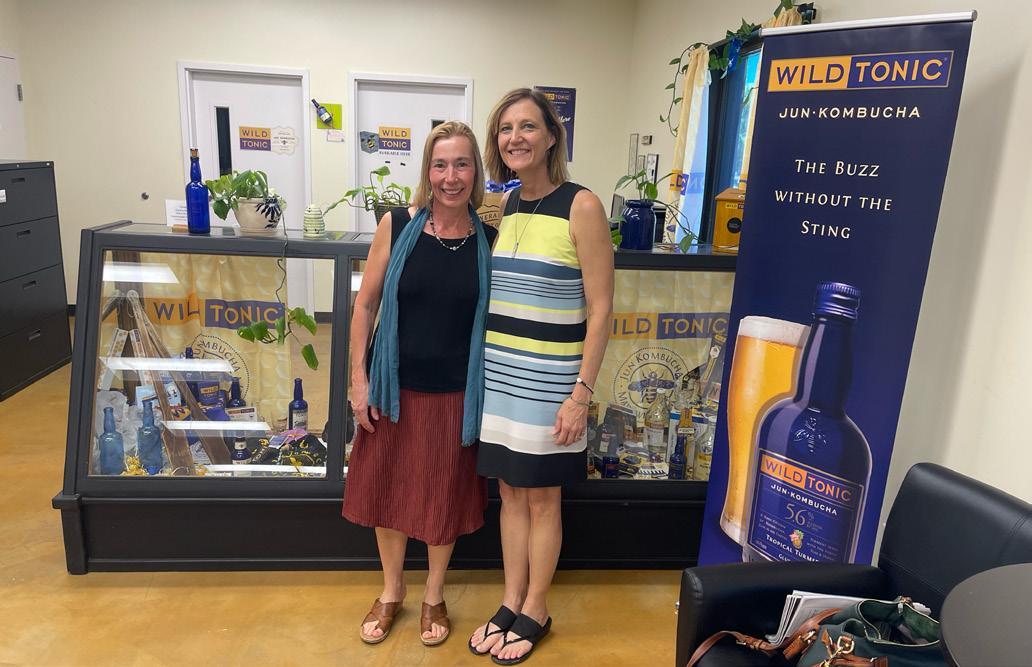





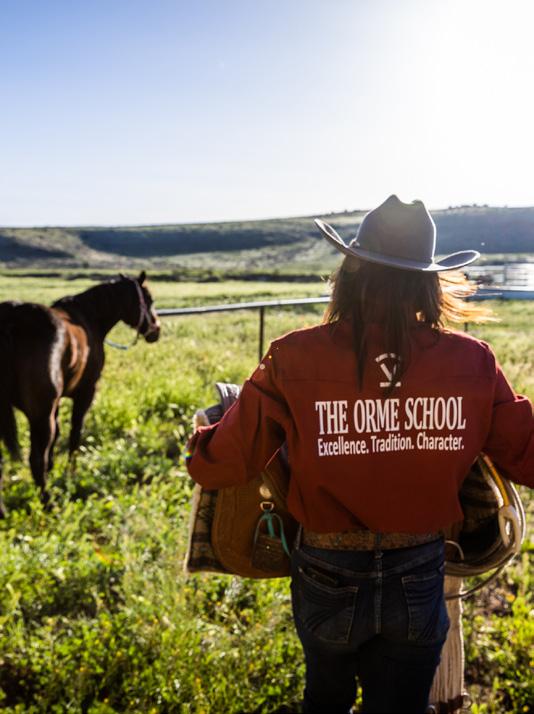
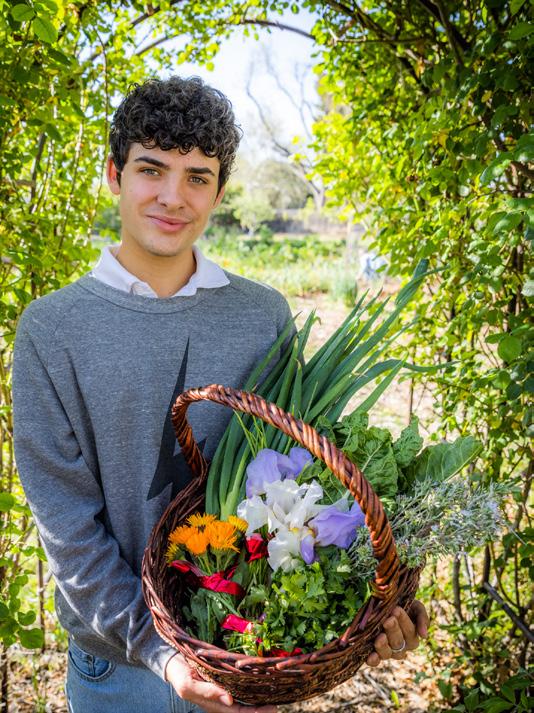
On August 1, LEGO released a 462-piece playset featuring solar panels, a charging point for the EV, conservatory with a dining area and a box for growing veggies. Builders can zoom in, rotate sets in 3D and track their progress using the fun, intuitive LEGO® Builder app.

On August 8, Arizona business and elected leaders marked the one-year anniversary of the Inflation Reduction Act. According to data released by the Environmental Defense Fund, explosive growth in battery technology has propelled over $10.9 billion in announced investments and over 11,500 jobs in EV and battery manufacturing in Arizona.

Arizona’s Candelaria Design was named a Golden Nugget Award winner in the “Innovative Housing –Technology” category for its 3D-printed home in partnership with Habitat for Humanity. The company also won a second award for “Best Custom Home” for a transitional 6,000-square-foot home they designed in Paradise Valley.


For the past 12 years, Scottsdale has been recognized as a gold-level bicycle friendly community by the League of American Bicyclists. Public feedback was garnered through a survey and is an important part of the application process when applying for certification. The city hopes to reach platinum-level certification this time around.
On July 19, the Center for Biological Diversity and Maricopa Audubon notified the U.S. Fish and Wildlife Service of their intent to sue the agency for its delay in protecting the survival and recovery of southeast Arizona’s Mount Graham red squirrels.





WFrom handy eco-friendly appliances to the products we use to clean them, the kitchen has become the hub of sustainability for many households around the globe. Here are a few products to make your kitchen just a little greener.
Raise your hand if you can’t survive without coffee, yet you want to be ecologically responsible. Maranello Caffe’s Pour-Over Coffee Dripper is for you! With a dishwasher-safe stainless steel design, this dripper eliminates the need for paper coffee filters. Plus, the dual filter design allows water to flow through the coffee grounds rather than around them, giving the coffee a more robust flavor. The fourinch base fits most cups, carafes, and thermoses. www. maranellocaffe.net/pourOver

There’s a solution to that “ugh” feeling when you forgot about the produce or cheese that’s gone bad on the counter or in the fridge. Food Huggers aim to keep produce fresher for longer by using 100% FDA food-grade silicone, which is dishwasher, freezer and microwave safe. The various designs create a tight seal that fully covers the open side of your open food product to keep it fresh. Food Huggers also offers stand-up Hugger bags that can store sandwiches and other food items, plus 100% cotton fabric bags (these can be recycled by the company) and stackable lids. Multiple products are nested or folded flat to reduce shipping space, and the company requires shipping partners to use 100% plastic-free packaging materials. Furthermore, Food Huggers products have a lifetime guarantee. www.foodhuggers.com
Ditch the plastic bottle for a dish wash block from No Tox Life. Just as powerful as store-bought dish wash, this sixounce bar cuts grime and grease on everything that goes in the sink. Grab a scrub brush and feel good about washing dishes, as the Dish Block is free of dyes and fragrances and is made with biodegradable and vegan ingredients. It contains no phosphates, sulfates, parabens, gluten or palm oil, and is cruelty-free and septic-safe. All that, and it’s gentle on your hands too, thanks to the added aloe vera. No Tox Life says the Dish Block can also take out laundry stains, remove stubborn labels off jars, spot clean your carpet, and wipe down your oven. Products are shipped in sustainable, plastic-free packaging. The company also reuses cardboard boxes from suppliers or ones that are donated. www.notoxlife.com

If you cook hard in the kitchen, you’re going to need a sponge that’s tough yet friendly to the environment. Two Acre Farm’s Eco Sponge is made from cotton and fair trade recycled coffee sacks and is 100% biodegradable. Each sponge can be cleaned in the dishwasher or can be composted when it’s at the end of its life cycle. Two Acre Farm also offers handmade organic soaps in many different fragrances with ingredients like coconut oil, oatmeal, and honey. www.thegreenway.ca/collections/two-acre-farm

Cleanliness is next to happiness, and what better way to secure that happiness than using a household cleaning product that is 100% plant-based? Caron and Doucet, a small but mighty Canadian company, offers products for those tough-to-clean kitchen tools such as cast iron skillets, BBQ grills, cutting boards, and stainless steel pots and pans. Beyond the kitchen, Caron and Doucet offers room sprays and wood and leather cleaners. There’s also a line of skincare products featuring balms, soaps, cleansers, and moisturizers. Products are free from sulfates, parabens, phosphates, and GMOs, and they’re cruelty free. The company has implemented a guaranteed living wage program and makes monthly donations to The Ocean Cleanup Foundation, which is estimated to remove 90% of floating ocean plastic. www.carondoucet.co

AAnticipation is steadily building among food enthusiasts and seasoned flavor adventurers alike. The Arizona Restaurant Association, recognized as a dedicated advocate and supporter of the state's hospitality industry, is delighted to announce the return of its noteworthy bi-annual culinary event, Arizona Restaurant Week (ARW). Running from September 8 to September 17, this event promises to bring countless delectable dining encounters to food connoisseurs across the state.
The 2023 Fall ARW promises to be a spectacle that draws attention to the state's restaurant industry. The event serves as an opportunity for patrons to immerse themselves in a culinary journey that spans a variety of restaurants, from chef-driven bistros to upscale dining venues. Keeping affordability in mind, the celebration aims to cater to a diverse range of tastes, allowing diners to sample an array of cuisines and dining atmospheres without breaking the bank.
President and CEO of the Arizona Restaurant Association, Steve Chucri, expressed his enthusiasm for this year's ARW. He explained that for more than 15 years, Arizona Restaurant Week has continued to grow in significance and popularity. The goal has always been to present both new and familiar dining options to patrons, ensuring that they have ample choices at their fingertips. It's an invitation to savor past favorites, embark on uncharted culinary voyages, and above all, extend support to an industry that thrives on a passion for excellence.
One of the defining features of the Fall ARW is the specially curated menus that showcase seasonal and exclusive ingredients. Diners can indulge in a threecourse prix-fixe menu, starting at an affordable $33 per person (other menus are crafted at $44 or $55
per person, or sometimes per couple). Diners who choose to enhance their dining experiences with wine or cocktail pairings can upgrade their meals for an additional cost.
As the countdown to the event continues, over 150 establishments have already joined the 2023 Fall ARW roster. Some noteworthy establishments committed to participating this fall include Alter Ego Kitchen and Cocktails, Obon, Fire at Will, The Italian Daughter, STK Steakhouse, and ZuZu at the Hotel Valley Ho.

For those hungry for more details, the official list of participating restaurants and their exclusive menus are available on the official Arizona Restaurant Week website. Regular updates can be found as new eateries and menus continue to be added, ensuring a dynamic culinary experience for all.
In short, Arizona Restaurant Week is prepared to tantalize taste buds, fuel diners’ passions for gastronomy, and reaffirm Arizona's stature as a culinary haven worthy of celebration. This event presents a unique opportunity to savor an array of dishes, support local eateries, and immerse oneself in the vibrant flavors of the Grand Canyon State. For further information, visit www.arizonarestaurantweek. com and get ready to embark on a delectable adventure. Let the feasting begin!



LLife after retirement doesn’t have to be stale, stagnant, or stereotyped. For some seniors, it’s the beginning of the third act — the time of life in which many human beings come into their own through years of experience and gained wisdom. By Broadway’s standards, the third act is when the main tensions of the story are brought to their most intense point, in which all of the main questions asked throughout the play are finally answered.
In September 2021, at 60 years of age, environmentalist, author, and journalist Bill McKibben founded a working group for “experienced Americans” — those over 60 — to bring together individuals with a multitude of life experience, skills, and resources to build a better tomorrow. He aptly named it Third Act. This past May, McKibben held a virtual meeting for Arizonans over 60 to introduce them to the organization's newest chapter.
McKibben has been passionate and active all his life. He wrote his first book about climate change, titled “The End of Nature,” in 1989, when he was just 29 years old. A dozen more books followed. With a passion for writing, McKibben has penned pieces for the New Yorker and numerous other national news outlets. He founded 350.org — a global climate movement that encourages renewable energy instead of fossil fuels — with a group of
university friends in 2008. The organization has hosted 20,000 demonstrations in every country except North Korea, McKibben said. In 2009, they hosted 5,200 simultaneous demonstrations in 181 countries.
Fueled by passion and years of experience in activism, McKibben didn’t slow down after retirement. He notes that older Americans are poised to be a powerhouse for protecting the climate and strengthening democracy.
“I looked around me and saw many others my age who were ready to go on working for a better future,” he said. Older Americans make up about 17% of U.S. demographics. McKibben and his generation saw a period of remarkable social, cultural, and political transformation, such as the women’s rights movement, the height of the civil rights movement, and modern environmentalism. It is firmly embedded in their generational DNA, he said. As he and his generation

moved throughout life in their “second act,” they may have been more interested in consumerism than citizenship, he says. Now many of them have grandchildren and great-grandchildren.
Though political scientists say people become more conservative as they age, McKibben doesn’t think that’s necessarily true. This generation has emerged in their third act with time, energy, and ability to renew youthful commitments to justice, he said.

Though the Arizona chapter is in the early stages of development, the group is looking forward to tackling local issues that align with Third Act’s national focus on the climate and democracy crises. State-level meetings are a mix of virtual and in-person, while various national meetings are virtual and include thousands of volunteers.
Members of Working Groups actively attend standouts and protests. McKibben said Third Act’s National Day of Action took place in March with demonstrations in 100 cities that protested banks funding the climate crisis. Other places had day-long sit-ins, but since they’re older, they made sure to bring rocking chairs, McKibben joked.
“In our younger years we wouldn't have imagined, say, that Lake Powell would shrink to nearly nothing, or that a mob would invade the White House and kill police officers to stop the counting of votes,” he said. “We don't want that kind of world.”
Members of the group have different experiences with activism. Some fought for women’s rights or the first Earth Day. Other people are spending well-earned free time getting to know the ropes of organizing and making an impact. Collectively, they want to make the best use of their remaining years. Not for themselves, McKibben notes, but for the greater good and future generations.
Third Act bridges the age gap, too. While the “Greta” generation is comprised of extremely passionate
young people fighting for our planet, McKibben said they lack the structural power to make change. And it’s no secret that people 60 and older are still the largest voting demographic in the U.S. McKibben recognizes that his generation, and those involved in Third Act, have the power to backstop the Gen Z vote and be “helpful as heck” in backing up young activists, he added.
It’s an effort that allows Third Act’s purpose to go beyond activism.
“It lets people become not just old, but elders [are] reaching back to help the next generations, and to learn from them at the same time,” McKibben said.
A 10-person advisory council, including McKibben, guides Third Act, while a smaller team organizes, campaigns, and coordinates operations. There are 15 Working Groups established around the U.S., with three more in formation. They also have four groups that focus specifically on retired union members, art creatives, faith groups, and educators. To sign up as a member of a Working Group, read the agreement and fill out the form online. To learn more about Third Act, visit www.thirdact.org.
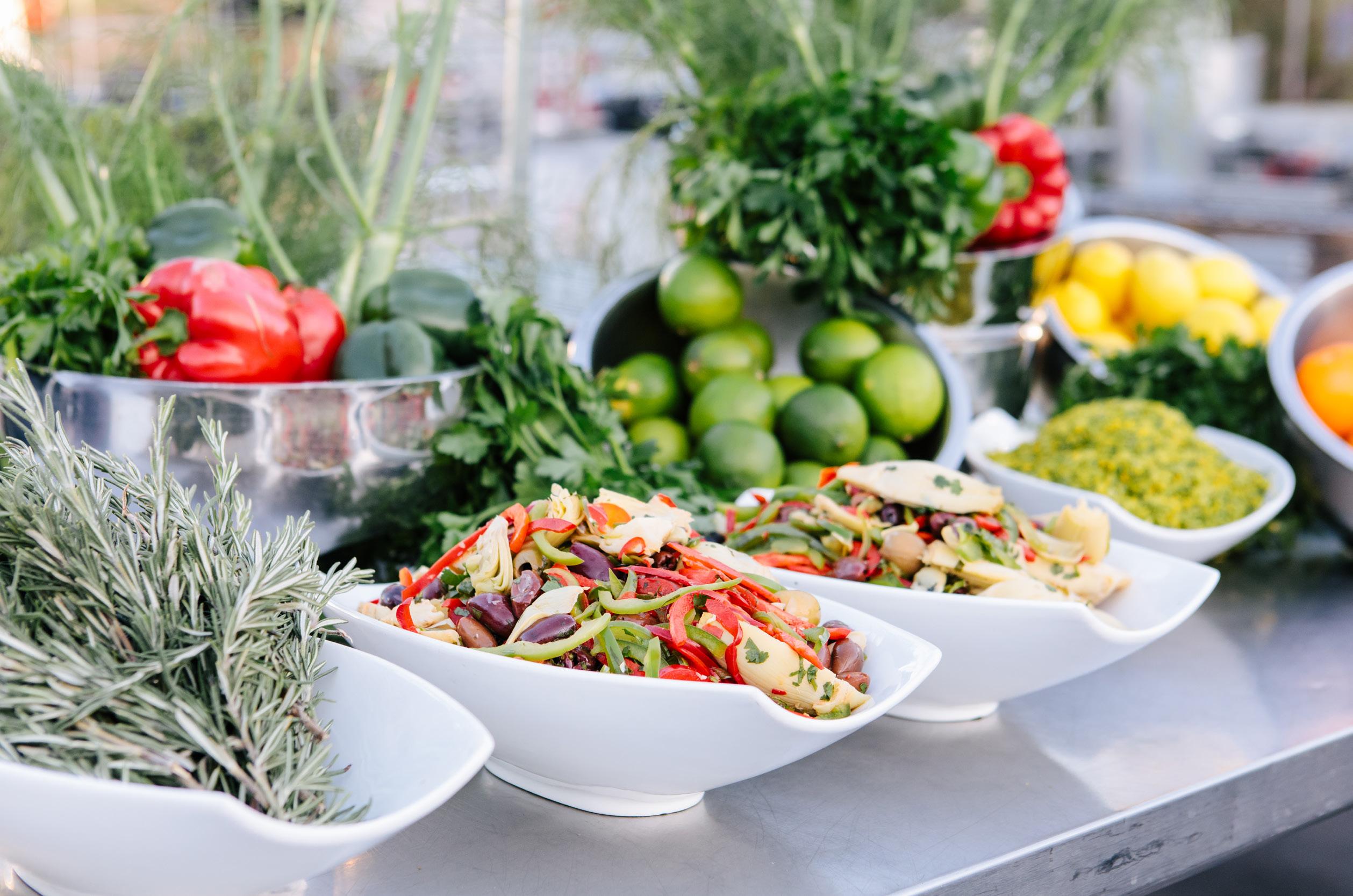 BY MICHELLE TALSMA EVERSON
BY MICHELLE TALSMA EVERSON
TTo Steve Short, COO and CCO (Chief Culinary Officer) of Atlasta Catering, sustainability isn’t a static achievement or one-time analysis and implementation — it’s an ongoing driver that needs constant attention. With this in mind, Valley-based Atlasta Catering has become a fully sustainable company — an impressive feat in the hospitality industry.
“Fifteen years ago, we embarked on the process of becoming a zero-landfill company, which affects each kitchen and facility we operate, in addition to each event we cater,” Short explains. “This was a logistical challenge that took about six years to fully achieve and, for the last nine years, we’ve operated as such.”
What inspired Short and his team to get started on their sustainable journey?
“Listening to the book Stirring it Up by Gary Hirshberg about Stonyfield Farm’s yogurt in 2008 started me on this journey of sustainability,” Short says. “It
gave me a tangible example of a business operating successfully while also operating mindfully.”
In the last thirteen years, Atlasta has diverted all its food waste from landfills and donated well over one million pounds of food – the equivalent of 600,000 meals – according to the company.
“Every last item that traditionally would be contributing to the landfill has been analyzed and either diverted or re-sourced for an alternative — something reusable, recyclable, or compostable,” Short says. “Truly, the biggest challenge for any
hospitality/food company is the diversion of food waste — whether it is a result of trim (watermelon rinds for example), food over-ordered or over-prepped, or food left on a guest’s plate.”

He adds that finding reliable and predictable means to divert food waste — through composting and supporting not-for-slaughter animal farms — and redirecting food that cannot be used (over-prepped or over-ordered) to the food insecure remain the most tangibly impactful processes in the company’s multifaceted sustainability philosophy.
“While waste diversion and operating as zero-landfill is a major component of our program, our entire company operates through an overarching lens of sustainability that influences our purchasing, our food philosophy, our energy choices, water usage, our carbon footprint, our cleansing agents, our workplace culture, and our community, both through indirect and direct impact,” Short continues.
To maximize results, the company’s sustainability efforts are led by experts and research. Their academic and scientific partnerships include teaching senior level students at ASU’s Global Institute of Sustainability and the Walter Cronkite School of Journalism in the areas of business, ethics, and sustainability. Short has been featured at national sustainability conferences, served as a member of the ASU Wellness Committee, and is involved in ASU’s food purchasing and sourcing as a member of the Sustainable Food Task Force.
“Our approach to sustainability is not limited to our on-premise kitchens. It travels with us to each event we execute across the Valley,” Short explains. “While the client and guest may not realize what is happening, every decision prior to arriving on site has been influenced by our sustainability guidelines, and every action on location is dictated by our sustainability framework.”
Sustainability has become a way of life at Atlasta
and is engrained in almost every detail. Beyond energy, water, solid waste, and packaging, Atlasta also utilizes software and technology to minimize paper waste, and menus are engineered to reduce overall carbon footprints, greenhouse gas emissions, supplier radius, and more. They also require as much transparent sourcing from vendors as possible and incorporate competitive wages for employees to build a sustainable work environment.
“Our entire team is made up of individuals who realize the importance of our methods and how each micro-decision impacts our overall success, by any measure,” Short explains. “Sustainability is a way for each of us to make an impact, make a difference, and to take pride in our work. Sustainability is a part of our culture and ultimately a driver of morale.”
To Short and his team, the company’s mission is both personal and professional.
“Personally, sustainability was a path that reconnected me to food and my family’s long history in farming and hospitality,” he says. “It provided me with an ‘aha!’ moment. I could reimagine every process and every decision to align with my own values, and it gave me a challenge — turning a hospitality business into a sustainably-minded operation that could affect change.”
Short adds that he sees sustainability as a responsibility in all industries.
“I believe every business has not just the ability, but the responsibility, to deeply evaluate its processes and make impactful changes. We are long past the age of greenwashing; customers are savvy and deserve transparency.”
“Sustainability provided me with the structure and ability to achieve functionality in a traditionally dysfunctional and wildly wasteful industry,” he continues. “The process-driven aspect, the constant evaluation needed, and the metrics for accountability, impacted and still impact every last facet of our business.”
To learn more, visit www.atlastacatering.com.
WWhen Nika Forte stepped on to one of St. Vincent de Paul’s urban farms in Phoenix eight years ago, she didn’t know her experience would one day bloom into a passion and a future career.

Farming had not been part of her youth growing up in Detroit and 25 volunteer hours on this farm would be required for her to obtain the urban farming certificate that would accompany her Mind, Body, Wellness and Transformational Psychology degree from the Southwest Institute of Healing Arts. It didn’t take long for her and the other volunteers to figure out that they weren’t there to do light gardening. They pulled out old crops and moved heaps of heavy soil on a warm September day. It was hard work, but by day’s end, it was a good feeling.
“It was something I really had not done before, but I was excited to put what I had learned from school into practice and at the end of the day, I was obsessed, and I just kept coming back every day,” she recalled.
Forte completed the required 25 hours for her certificate in one week, and soon she was a regular volunteer. After she graduated with her associates degree, St. Vincent de Paul reached out and asked her to work as an employee.
Her response was an emphatic, “Absolutely!” she says.
Forte served as an AmeriCorps ally for the first two years, helping with educational programming and starting a junior master gardeners program where she taught seed-saving and how to grow food in a container. Forte worked her way up from there to program coordinator, to farm manager at one location, then farm manager for all three locations. Today she is St. Vincent de Paul's director of urban farming.
St. Vincent de Paul is an international nonprofit that serves people in need through its various food pantries, charity dining rooms, transitional shelters, and resource centers. The organization also operates a nonprofit clinic offering medical, dental, and wellness care for uninsured individuals. The organization has helped people in central and northern Arizona since 1946.
Forte hasn’t been homeless, but she has been hungry, she said. As a former single mom, she’d ride the bus to the grocery store, kids in tow. She often was faced with the reality of needing to choose the foods that were most affordable versus the foods that were the most healthy in order to make ends meet, using what was left over for bus tickets and daycare.
“I know what it means to be food insecure, and in this country, we throw away so much food, and we waste so much food, and there’s no reason why anybody should go hungry,” she said. “But it happens. I’m just glad that I can be part of the solution to help end hunger.”
That fulfilling and amazing feeling of helping others is the reason why she gets up everyday and heads to the farm.
“There's nothing like putting a seed in the dirt, watching that plant grow, harvesting those vegetables
and then taking it into the dining room and seeing them eat it,” she said. “That is the most fulfilling and amazing feeling.”
In Phoenix, St. Vincent de Paul’s three urban vegetable farms help feed a population in need and educate people on growing their own produce. Produce, herbs, and edible flowers are the main features of the farms, along with a few orchards.

Beyond caring for the farms, Forte meets many different people, which is another reason she loves what she does. From young to old, volunteers and community members make up 95 percent of St. Vincent de Paul’s workforce.
“I’m doing something that can leave a lasting memory in some of these individuals’ lives, whether that’s the students that were in my junior master gardeners class, or a donor that showed up to do a tour,” she said.

Sustainability plays a key role in keeping the farms going, especially in the hot summer months. Produce is grown by season, and most of the crops are watered at night on a timed drip system to conserve water and save money. Shade trees extend the growing season and shield plants from the sun during the hottest parts of the day. Seeds are saved from the plants that do the best throughout the year and are planted again the following year. On one of the farms, 23 chickens provide fertilizer and till the dirt. And in the spring, bees visit the lush garden to pollinate a bevy of flowers and native plants.
When there are enough volunteers, a composting program is used to break down scraps from the dining room and kitchen to feed the plants. Because
composting takes a lot of skill, time, and patience, it’s not possible for just one full-time employee at each farm to manage. Currently, the program is paused but Forte notes that they’re working on collaborations with local college students in sustainability programs to bring the program back.
Forte hopes for each farm to eventually have an educational greenhouse that will expand St. Vincent de Paul’s footprint in educational programming and community engagement through hands-on learning. Beyond teaching others, it’s a chance to give back to the community that supports the mission.
“Our goal is always to educate those on how to be more sustainable, how to be environmental stewards, how to grow your own food and be self-reliant,” she said.
She also wants to make sure that any available space is utilized creatively to its fullest potential, reenvisioning places to grow food that would not normally be used for that purpose.

For Forte, the farm has become an irreplaceable part of her life. She’d like to have her own farm one day where she and her husband can retire.
“You can’t get me out of the farm. Now I’m in the garden six to seven days out of the week,” she said.
Forte is also expanding her skill set by founding Baehive, a sisterhood of beekeeping women. She learned the basics of beekeeping at St. Vincent de Paul and continued her research to find that there were not a lot of women in the industry. Currently, the industry is dominated by men, mostly white.
Baehive’s goal is to teach more women and women of color how to keep bees.
“I feel like when you teach a woman a skill, you’re teaching a civilization — our nation — a skill,” she said. “I wanted to build a sisterhood around beekeeping and just get more of us involved in beekeeping.”
The group of about 30 women mirrors the structure of a beehive, too. About 98 percent of the hive is female, and the bees work together to keep each other alive, fed, happy — and everything they do is for the good of the colony as a whole. That’s what a sisterhood should be, Forte said.
Baehive’s purpose isn’t necessarily honey production, but if there’s an overflow of honey or if one of the boxes needs to be downsized, Forte sells the honey at the farmer’s market at the community garden she runs on her own or sells it at Grassrootz, a blackowned bookstore in Downtown Phoenix. The money goes right back into beehive production to continue the sisterhood.







 BY ANGELA FAIRHURST
BY ANGELA FAIRHURST
WWellness – that is, what will best support our mind, body, and soul now and in the future – should be part of our everyday life. The best foods for health, wellness, and beauty are those that are rich in essential nutrients, antioxidants, and other beneficial compounds.
Incorporating these foods into your diet can help improve your overall well-being, support a healthy body, and contribute to a radiant appearance. Consider adding these to your breakfast, lunch, or dinner line-up for some well-known benefits:
Fruits and Vegetables are packed with vitamins and antioxidants that promote skin health and overall wellness. Strawberries, blueberries, and raspberries are particularly rich in antioxidants.
Leafy Greens provide an excellent source of folate and fiber, as well as a host of immune-support benefits through these superpower vitamins:
Vitamin A supports vision, immune function, and skin health.
Vitamin C helps protect cells from damage caused by free radicals and assists in collagen synthesis and immune support.








 BY MISTY MILIOTO
BY MISTY MILIOTO
CChefs across the country are starting to catch on to the phenomenon of dry-aging fish as a way to reduce waste and develop creative dishes. Here, we caught up with two chefs — Michael Nelson, executive chef at GW Fins in New Orleans, and Colin Whitbread, chef and co-founder at Fiish in Los Angeles, to get the angle on this innovative and sustainable method.
From his perch as executive chef at GW Fins, a seafood-forward restaurant in New Orleans’ French Quarter, James Beard Foundation Award-nominated Michael Nelson resolved to innovate seafood during the pandemic. He decided to try dry-aging fish — a tradition that sushi chefs in Japan have mastered over the years.
“From my 18 years of experience specializing in fish, I know that fresh fish tastes better a day or two out of the water,” Nelson says. “It needs time to rest and relax to let the flavor develop, so I was curious what the dryaging process would do. I heard about some chefs doing this with incredible results in Australia, and one chef in LA, and I wanted to try it. I did a lot of research and was intrigued by the idea of being able to modify and enhance the flavor and texture of the fish to such a dramatic degree.”
Nelson started off dry-aging tilefish, which he says has a watery consistency and skin that one would never want to eat. After just five days in the dry-aging cabinet, the flavor of the fish was dramatically more pronounced, the fish became more dense, and the skin had a crispy, almost cracklin’-like texture.
After a lot of experimentation, he found the perfect formula for dry-aging a variety of fish. Since then, he has dry-aged everything from Ora King salmon to swordfish, snapper, and more. However, he has found that bluefin tuna, yellowfin tuna, and swordfish are the perfect fishes to dry-age.
Today, Nelson is one of only a few chefs in the United States to use a temperatureand humidity-controlled environment to dry-age fish. At any given time, there could be up to 1,000 pounds of fish in the dry-aging cabinets at GW Fins. And
guests at the restaurant are not only ordering the dryaged fish again and again — any type of dry-aged fish is the first dish to sell out every evening — but they are also leaving with rave reviews.
In addition to creating really tasty dishes, dry-aging also reduces a lot of waste.
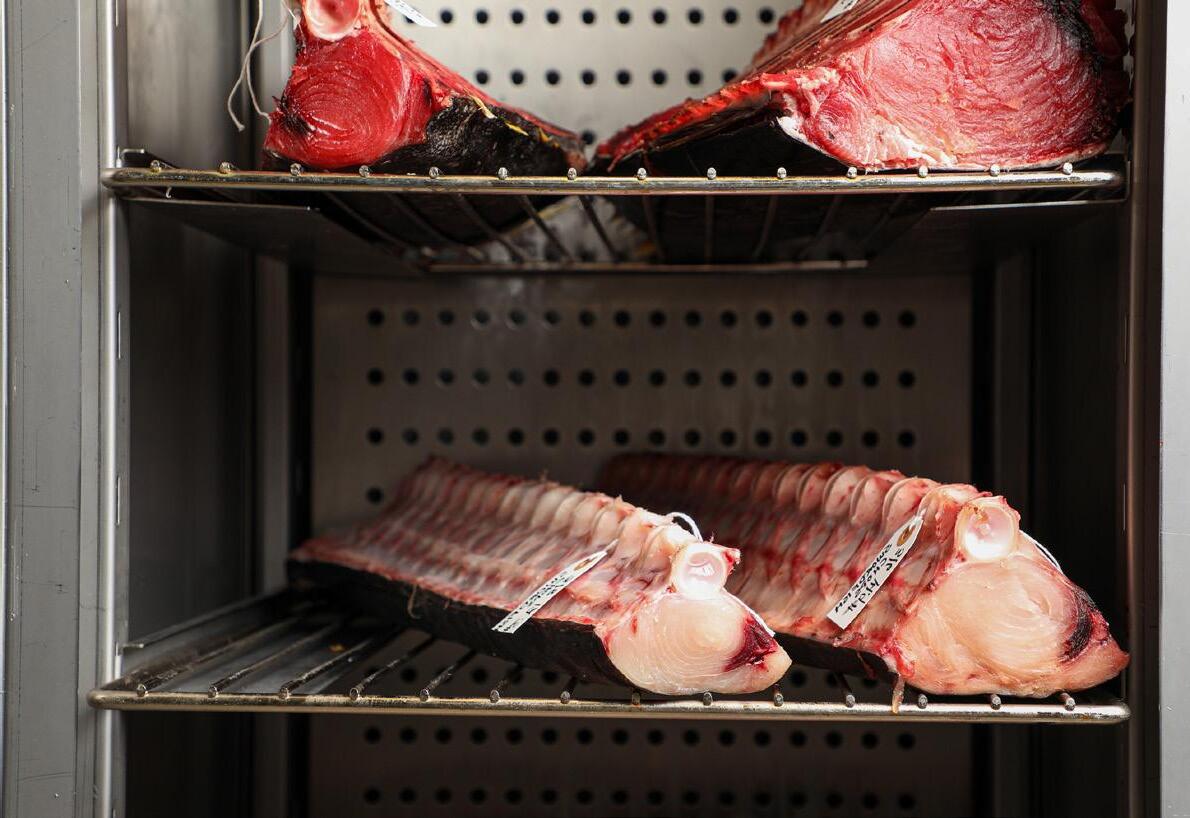
through his doors, which is between 700 to 1,000 pounds per day. The James Beard Foundation even had Nelson conduct a boot camp for other chefs to show them how to adapt these butchering skills to increase fish utilization.
Through the process of dry-aging and using innovative butchering techniques to yield unique cuts of fish, Nelson has added some creative dishes to the GW Fins menu, like crispy fish bellies and the popular tempura fin wings (fish collars) served with a Korean glaze.

There’s also inspired seacuterie, which came about from Nelson’s butchering techniques. He has made everything from kielbasa and andouille sausage to pepperoni and more using parts of the swordfish other than the filet. These modified dishes taste just like pork but without the high fat content. Nelson even has used his seacuterie to re-create the iconic New Orleans sandwich (the muffuletta) as well as a bacon cheeseburger slider — using only swordfish. Both of these dishes are served as appetizers when available. The menu changes nightly and is printed at 4 p.m. based on the fish that is available each day. 808 Bienville St., New Orleans, 504.581.3467, www.gwfins.com
“We only get in whole fish at GW Fins, and when we get a several-hundred-pound swordfish or tuna, even though we’re busy, we can’t go through that product right away,” Nelson says. “Dry-aging allows us the opportunity to break the fish down and serve a large portion of the fish, then also put some in the dryaging cabinets where it stays for about two weeks.”
As part of his mission to increase seafood sustainability, Nelson has come up with some innovative ways to butcher fish in order to use almost every part, from fin to tail. In fact, his butchering techniques yield 60% more meat (leaving virtually no meat on the scales) from every fish that comes
Colin Whitbread is a sushi chef, surfer, and artist who is passionate about the ocean and sustainable seafood practices. He has operated an ethically sourced sustainable sushi business for more than 15 years, with a focus on line-caught seasonal local fish and sustainable farm-raised products. In 2021, Whitbread and his chef partner Cody Requejo co-founded Fiish — a sustainable sushi restaurant located in Culver City’s Platform LA — specializing in sustainably sourced, dryaged fish and innovative sushi. The original pop-up location also in Platform LA, dubbed Little Fiish, was a fast-casual concept where guests could order bento boxes made-to-order, salads, and natural sodas. At the same time, Whitbread and his team worked on the build-out of the main Fiish restaurant.
“We were excited to start sharing our vision and teaching the community about what we love to do,” Whitbread says. “We quickly closed up the physical shop once our build in the main restaurant was completed and resumed this concept for take-out only through Fiish as a convenience for those on-the-go as an alternative to a seated meal at the sushi bar.”
For Whitbread, sustainability is front and center at Fiish.
Photo courtesy of GW Fins“By choosing to go in the sustainable direction, we are making an effort to prepare our food system for the future,” he says. “Trying to be low- or zero-waste and trying to be conscious of the products we’re using and how they are created is going to help. It is, for me, the most important aspect of being a chef: trying to create a new food system that can evolve with time and be able to adapt to the growing needs and pressures that are being put upon the culinary world.”
Whitbread and Requejo source the majority of their fish directly from local docks and sustainable
aquaculture farms that have Aquaculture Stewardship Council certifications and a Best Aquaculture Practices rating. Both of these systems focus on traceability, environmental impact, feed ratios, pen densities, chemical treatments (antibiotics), and social responsibility.
For example, the chefs source Fiish’s striped bass from Pacifico Aquaculture, a farm that offers open-ocean raised, sashimi-grade striped bass off the coast of Todos Santos Island, Mexico — just three hours away from the restaurant, making it Fiish’s most local catch. Meanwhile, the Ora King salmon comes from New Zealand King Salmon, a company committed to sustainability, environmental responsibility, and the highest standards of fish welfare. Other sustainably sourced fish include Omega Blue Kanpachi from La Paz, Mexico; stone bass from the Ionian and Aegean seas in Greece; Albacore tuna from Fiji; Bigeye tuna from Honolulu; and Vermilion rockfish from San Francisco.
Once Fiish receives the fresh catches, the team processes the fish and dry-ages it for five to 12 days, depending on the species. In doing so, Fiish is able to serve premium, neverfrozen seafood, while also allowing its chefs elasticity in the supply chain, resulting in reliable stock and minimal loss.
“I believe [dry-aging] will become more popular as the information gets out there and people have more experience in doing it,” Whitbread says. “It will most likely be one of the most popular methods used in fish production and fish longevity in the future for chefs.” 8820 Washington Blvd., Ste. 101, Culver City, 323.272.2262, www.fiish.co
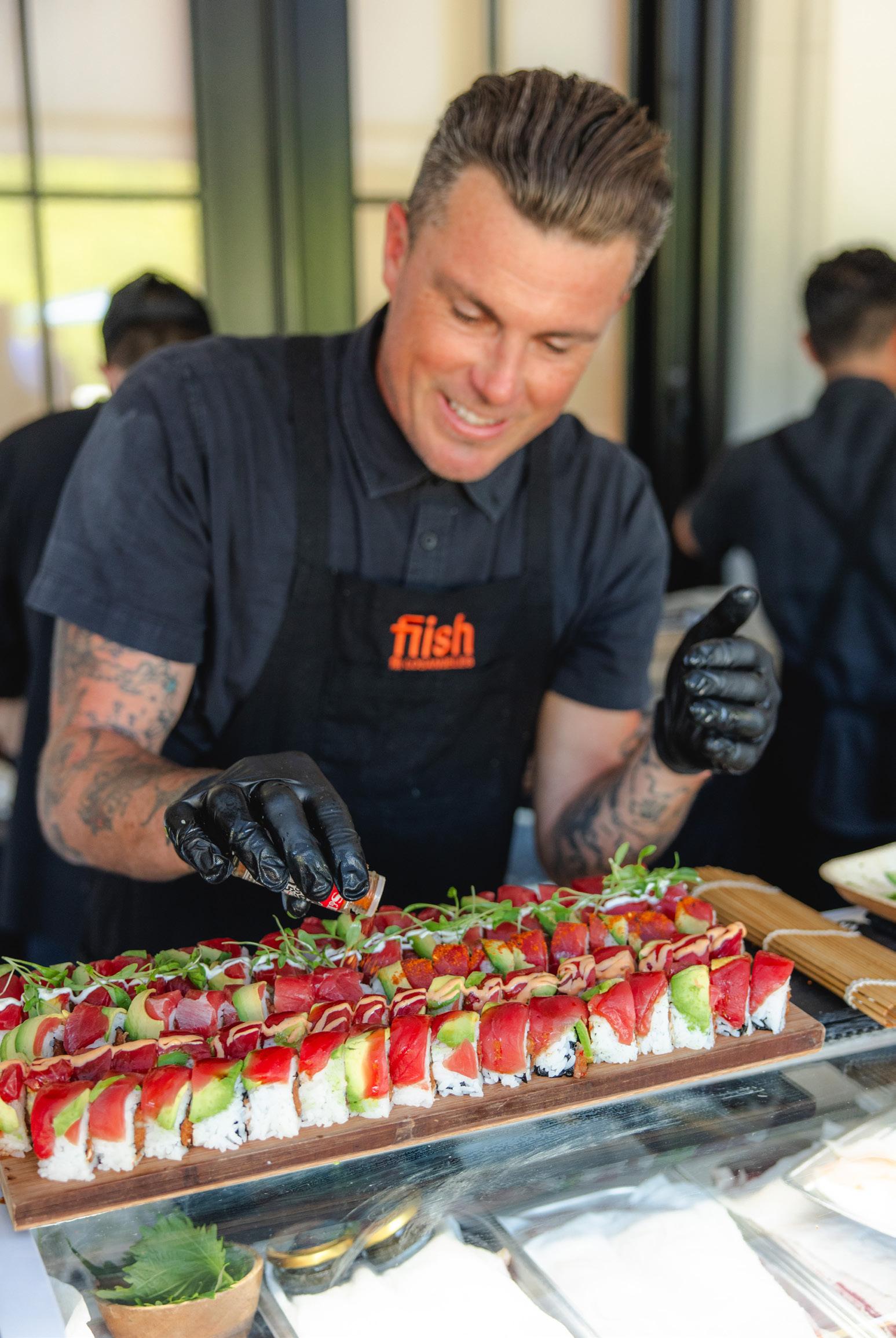
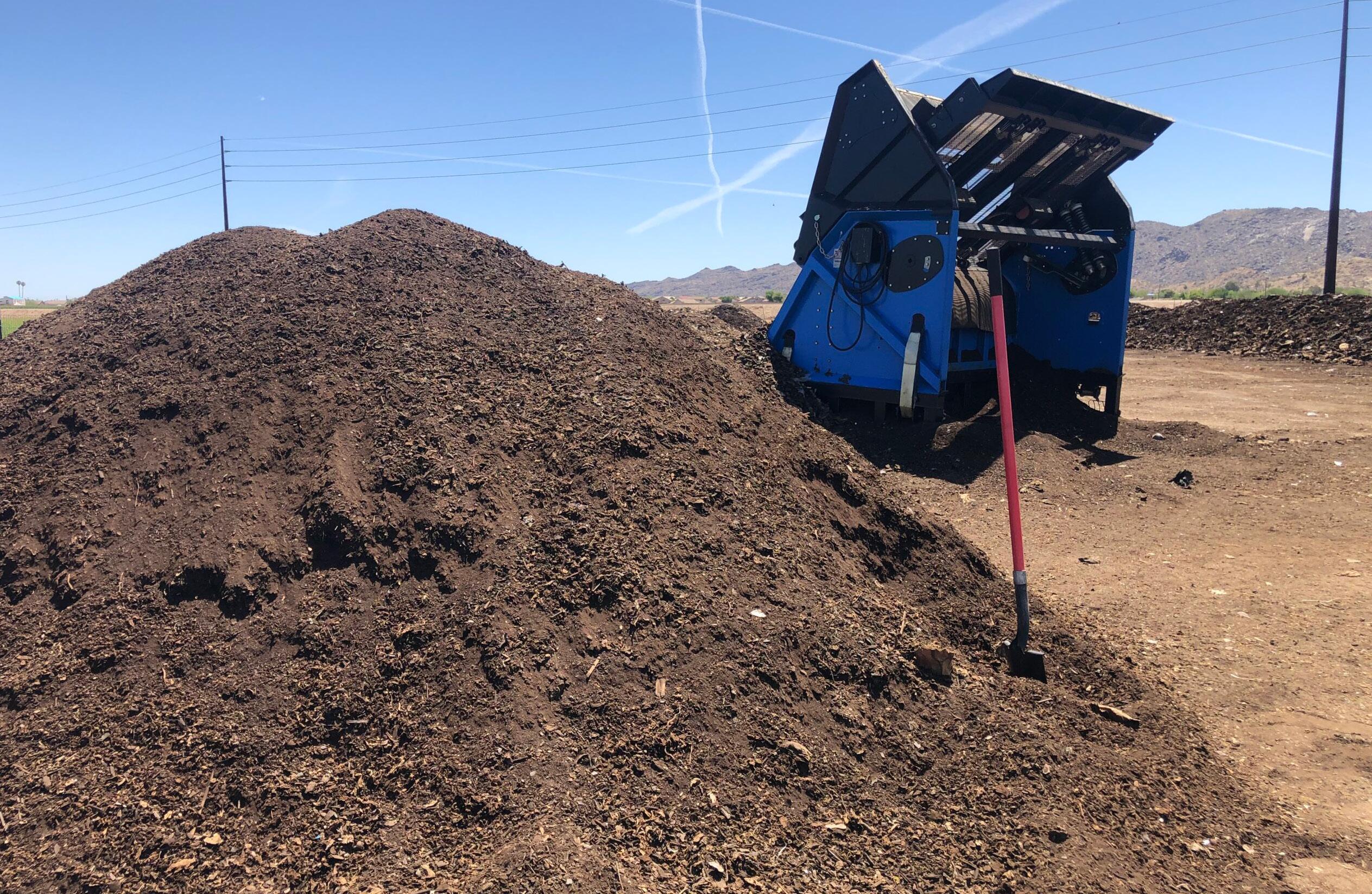

 BY JORDAN GERARD
R.City greenhouse.
Photo courtesy of R,City
R.City compost pile. Photo courtesy of R.City
BY JORDAN GERARD
R.City greenhouse.
Photo courtesy of R,City
R.City compost pile. Photo courtesy of R.City
IIn the United States, the Department of Agriculture estimates that between 3040% of our food supply goes to waste. The Tempe Restaurant Composting Project — designed by Local First Arizona, R.City, and the City of Tempe — wants to change that, with a goal of creating a circular food system. By November 2024, they want to convert roughly 300,000 pounds of food waste into 80,000 pounds of compost that will work to grow new food in Arizona.
The program has been offered to locally owned restaurants along Apache Boulevard, a business corridor that has been suppressed for a long time, according to Nick Shivka, Local First Arizona senior manager of sustainability initiatives.
Benefiting from the Valley Metro light rail and the Tempe Streetcar, the Apache Corridor is coming back to life, and now is a critical time to offer support to businesses in the area. Healthy businesses mean healthy and safe neighborhoods, in addition to income for the families who own those businesses. According to Shivka, many of this neighborhood’s restaurant owners have heritages that span the globe. Over 100 different languages are spoken in just one square mile.
“These businesses are so important because they circulate local dollars in the economy, hire local workers who are connected to their places, and it's a haven for culturally familiar food for those who have

relocated here to the U.S.,” he notes.
Cocina Chiwas began participating in the Tempe Restaurant Composting Project in August. Husband and wife team Armando Hernandez and Nadia Holguin opened the restaurant at the beginning of 2023, adding it as another unique concept to their already well-established list of restaurants in the Valley. The restaurant is currently located in Cul-deSac, the first car-free community in the U.S.
The Hernandezes are originally from Chihuahua, Mexico, and many of their employees have ties to different regions of the country, as well, General Manager Adrian Galindo said.
“It’s something we’re all very firmly connected to and want to spotlight a little bit more,” he said. “Mexico is this gigantic country with several ecosystems. You get a variety of cuisines across Northern Mexico, Southern Mexico, Central Mexico. They all have their own expressions.”
The menu at Cocina
Chiwas is anything but typical. Creative dishes — like oysters in a jamaica and habanero mignonette — are plentiful across the elevated menu. But beyond the food, Galindo said they want to be active in helping the local environment. He adds that Local First Arizona was instrumental in helping the restaurant get set up with the ability to compost, as it can be difficult to know where to start.
“I think it'll be a fantastic program,” he said. “We really want to help them grow it out and kind of [complete] this supply chain around local farmers [and] local restaurants.”
restaurants become more sustainable, even though sustainability is often talked about as being “too expensive.” Because food production and food waste combine to create approximately 32 percent of global greenhouse gas emissions, the ability to reduce food waste becomes a basic need when referring to sustainability. Composting is a good way to start.
To be clear, food waste isn’t necessarily a restaurant’s fault. It’s a problem with a lot of different causes, including legislation and its effect on agricultural practices, human behaviors, and food label education and awareness. It’s not top-of-mind in the U.S. because we don’t have strong policies that encourage businesses to compost, Shivka said. According to ReFED, a national nonprofit that is dedicated to ending food loss and waste, Arizona wasted about 2.37 million tons of food in 2021.
“It’s also an opportunity for [the restaurant owners] to kind of give our local food economy a kickstart into transforming into a sustainable local food economy,” Shivka said.

To launch the program, Shivka met with owners or managers of local restaurants along the Apache Corridor to talk to them about their business goals. He performed an audit on the restaurants to identify points of waste generation and provided an assessment of how each restaurant could incorporate composting without making it harder on operations.
Training on what can and cannot be composted will help to educate employees and help them shift their habits when it comes to discarding food waste. Galindo isn’t exactly sure how much waste the restaurant produces currently, but he’s happy to have the program in place for a planned expansion to include weekday lunches and weekend brunches.
Shivka said several goals drove the Tempe Restaurant Composting Project to fruition. His goal is to help
“We’re actually hoping to make waste (disposal) easier for the restaurant. A lot of businesses haul 200-pound bags of garbage,” he said. “But with this program, they are getting this compost barrel that would be right outside their back door. They don’t have to haul it that far.”
After a restaurant signs up for composting collection, Local First Arizona helps them collect data on the weight of their food waste to see how much they’ve helped divert. It’s a tangible way to see how much food is going into the
compost bin. It changes human behavior to see things not as waste, but as an opportunity to do good for the environment, Shivka said.
Local First Arizona also assists restaurant managers and owners in customizing a training program for their staff and provides them with the necessary autonomy to implement it, recognizing that they know their employees best.

While restaurants can’t control how much food customers want, they can control how much they order on the front end and how they prepare their food. Streamlining menus to avoid specialty ingredients that are used only in one or two menu items is another effective way to reduce food waste. Utilizing seasonal foods and produce that are grown locally also serves to reduce greenhouse gas emissions from products that are trucked into the state.
R.City — a Valley-based composter that offers food waste diversion in Phoenix and the surrounding Metro area — conducts the compost pick up and, in concert with the City of Tempe, will provide each restaurant with free pick up for the first six months. It’s just $20 a month thereafter for as many pick ups as needed. Trucks go out seven days a week to collect and empty compost bins. The compost comes back to the farm, where a team of 20 employees rotates the food scraps and compostable items. The resulting mixture breaks down into compost over a six-month period.
Not only is this program good for the environment, it’s also good for the community itself.
“When we find ourselves at the center of that circular economy, it’s because of us that this place is not only able to exist, but they kind of persist,” Shivka said. “[They] develop that hometown pride.”
Composting is a skill that might take some time to learn, but the end goal is rewarding. For backyard
composters, the rules of what can be composted are a little more stringent because it can be difficult to keep the right moisture level and – for the average composter – it can be more difficult to rotate the mixture, Jessica Spriggs, administration for R.City said. Food scraps, pizza boxes, paper towels (that haven’t been used with chemicals), and other compostable items are accepted. Produce grown in compost is more nutrient dense and avoids the need for chemicals or pesticides.
“Our soil is really being depleted,” Springs notes. “If we just grow and take that food and those scraps and send [them] to the landfill, we’re not putting nutrients back into the soil.”
R.City collects compost bins from businesses and homes around Tempe and the Phoenix metro area. The company is celebrating 10 years of business this year and has over 150 commercial businesses on its pickup list. Familiar names include Four Peaks Brewing Co., Cartel Roasting Co., and First Draft Book Bar, among others. Spriggs said they’re happy to offer services wherever people are located within the service area and happy to help train businesses on what is and is not compostable.
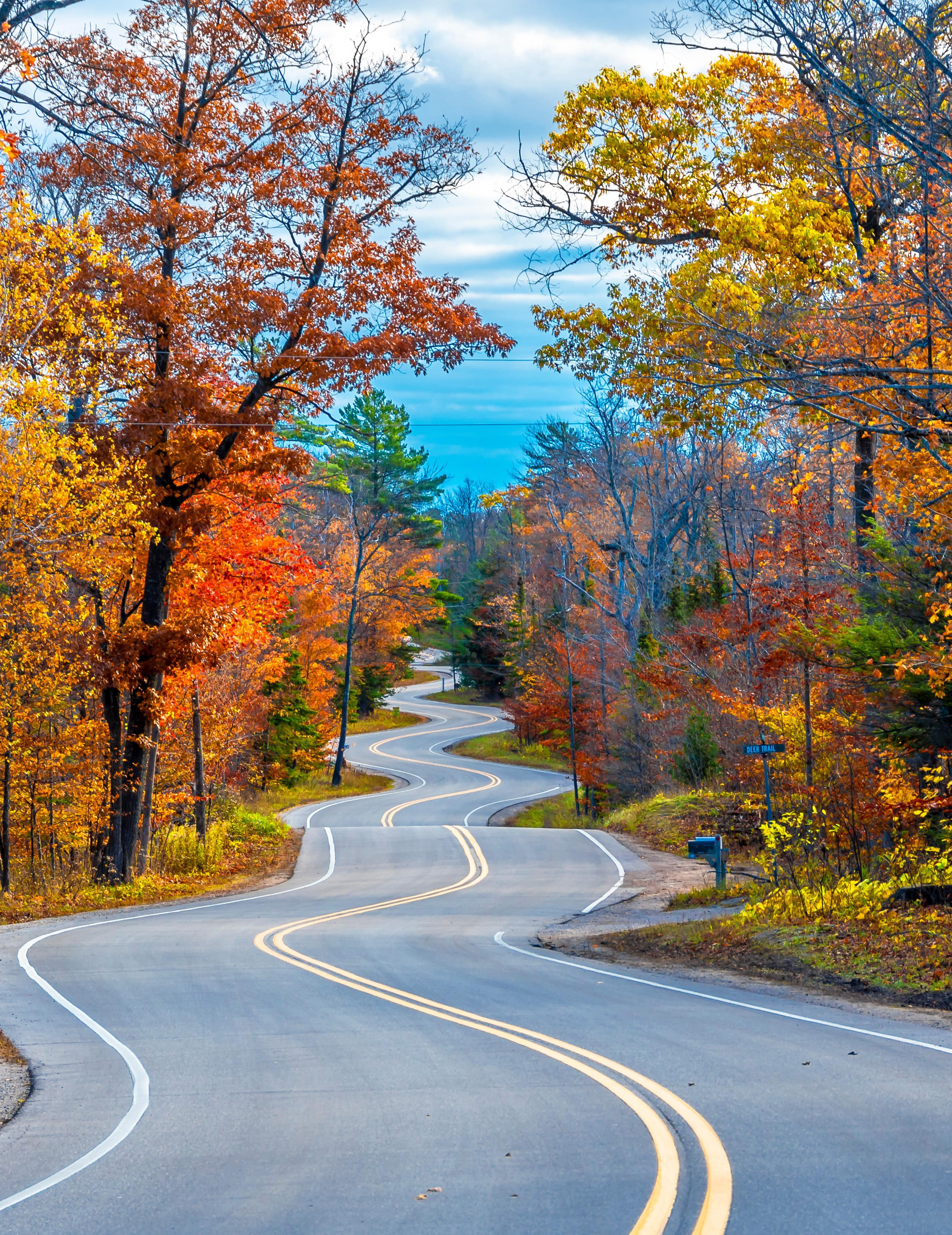
LLocated on a peninsula between Green Bay and Lake Michigan, Door County is affectionately known as the Cape Cod of the Midwest. This popular getaway (in May through October) also is known for its long shoreline, fresh fish, numerous parks and outdoor activities, and an entrepreneurial spirit that has given birth to many locally-owned and operated shops, restaurants, distilleries, and breweries.
In fact, in the late 1600s, French explorer Pierre-Esprit Radisson declared the region “a kingdom so delicious.” Over time, Door County has become one of the Midwest’s favorite culinary destinations, with cherries — both sweet and tart — appearing as the star of many dishes.
Door County also boasts robust sustainability practices, including a partnership with the Leave No Trace Center for Outdoor Ethics, an organization dedicated to land protection. Initiatives include the creation and promotion of Door County’s seven Leave No Trace principles (such as sticking to trails and respecting wildlife); access to research, training programs and educational programs; and working with land managers to create Gold Standard Sites.

Additionally, more than 20
establishments in Door County — including inns and resorts, restaurants, retailers, and attractions — are part of the Travel Green Wisconsin program (a state-sponsored sustainable travel green certification). These businesses purchase local fruit, vegetables, fish, and other food staples — along with organic cleaning and recycled paper products — to support local businesses and lessen their environmental impact. Their efforts are further carried over into waste reduction, as well as water and energy conservation practices. In one year, Door County’s Travel Green Wisconsin establishments saved more than $17,000 in energy costs and reduced annual carbon dioxide emissions by more than 207,000 pounds.
Other sustainability initiatives include the Door County Green Fund (invests in environmental
education, funds land preservation, protects native species, and supports other types of green projects); an electric vehicle charging station mini grant program (awards in the amount of $1,000 are available to any Door County business, nonprofit organization, or government entity that wants to add or upgrade its public-use electric vehicle charging infrastructure); Care for Door County (a program that invites locals and visitors to aid in the protection of the area’s culture and ecology); and the Door County Land Trust (to preserve, maintain, and enhance lands that contribute significantly to the scenic beauty, open space, and ecological integrity of Door County).
The Landmark Resort - Recognized as a Travel Green Wisconsin business, The Landmark Resort offers 16 suite types (from one bedroom and one bath to three bedrooms and two baths) with views of either the woods or Green Bay. All suites feature fully supplied kitchens, free WiFi, flatscreen televisions, and a balcony or patio.
suites, and cottages that are open year-round. Located in Fish Creek, one of Door County’s most beautiful communities, the inn offers accommodations with private bathrooms, most with fireplaces, and many with whirlpool baths.

There’s also an onsite Travel Green Wisconsin restaurant that offers some of the best breakfast in the county (try the Door County cherry-stuffed French toast), plus candlelight dinners and traditional fish boils (more on this in a bit). 4225 Main St., Fish Creek, 920.868.3517, www.whitegullinn.com

Westwood Shores Waterfront Resort - Yet another Travel Green Wisconsin resort, Westwood Shores Waterfront Resort offers 38 suites — all with breathtaking sunset views of Green Bay — plus private bedrooms, living, and dining areas, and complete kitchens with full-sized appliances. The resort also features an indoor pool, a seasonal outdoor pool, a whirlpool, a sauna, and a fitness room. 4303 Bay Shore Drive, Sturgeon Bay, 920.746.4057, www.westwoodshores.net
The Landmark Resort also is home to Carrington, an upscale-casual restaurant with a full bar and award-winning cuisine. Try the walleye piccata or the Carrington ribs served with cherry barbecue sauce. The resort features four heated swimming pools (three outdoors and one indoors); whirlpools; steam rooms; tennis, pickleball, basketball, and shuffleboard courts; a fitness center; a park with playground equipment; and nature trails. 4929 Landmark Drive, Egg Harbor, 920.868.3205, www.thelandmarkresort.com
White Gull Inn - Another Travel Green Wisconsin lodging option, The White Gull Inn features rooms,
From locally grown lavender to fruit orchards and Lake Michigan fisheries, the agri-tourism industry works closely with local entrepreneurs to create fresh cuisine; cheeses; and wine, beer, and spirits. In fact, Door County’s wine making, distilling, and brewing scene has been expanding rapidly, putting the peninsula on the map for being a pioneer of drink.
Al Johnson’s Swedish Restaurant - This authentic Swedish family-owned restaurant has not only an amazing menu but also a herd of goats that graze atop the restaurant’s sod roof. Located in Sister
Landmark Resort. Photo by Brett KosmiderBay, Northern Door County’s largest village, Al Johnson’s is a Travel Green Wisconsin restaurant that has been a dining destination for more than 50 years. Breakfast is served all day (with items like Swedish pancakes with lingonberries), and the lunch menu features dishes like pickled herring, homemade Swedish meatballs, and Lake Michigan fried perch. Next door, Stabbur at Al Johnson’s is a family-friendly outdoor beer garden serving an expansive menu of draft beers, wines, aquavit shots, and handcrafted cocktails. After dining and imbibing, be sure to stroll the 1,900 feet of public waterfront, featuring a beautiful beach and marina, shops and galleries, and cozy coffee shops. 10698 N. Bay Shore Drive, Sister Bay, 920.854.2626, www.aljohnsons.com
starters, then end with an ice cream soda, sundae, or extra thick malt. While you’re here, be sure to get a selfie at this Instagram-worthy spot. 9990 Water St. S., Ephraim, 920.854.2041, www.wilsonsicecream.com

Old Post Office - The fish boil tradition first began as an economical way to feed large groups of hungry lumberjacks and fishermen. Local churches and restaurants eventually picked up the tradition, featuring freshly caught Lake Michigan whitefish, potatoes, onions, and Door County cherry pie. The fish boils at the Old Post Office in Ephraim have become a dining tradition, putting on quite a show with the fish cooked over an open fire just as it was done 100 years ago by the Scandinavians who settled on the peninsula. 10040 N. Water St., Ephraim, 920.854.4034, www.oldpostoffice-doorcounty.com
Wilson’s Restaurant & Ice Cream ParlorAlso located in Ephraim, this classic Door County landmark (since 1906) features an old-fashioned soda fountain, ice cream specialties, home-brewed draft root beer, flame-broiled burgers, and jukeboxes. Be sure to order the cheese curds on a bed of fries for
K.K. Fiske Restaurant, Granary Saloon & Coop Hangout - Washington Island, Wisconsin’s largest island (at 36 square miles), is dubbed The Crown Jewel of Door County. It’s located north of the tension line (the line marking the halfway point between the Equator and the North Pole). Hop on the Washington Island Ferry Line (also a Travel Green Wisconsin company), and grab lunch at K.K. Fiske. The restaurant is known for its freshly caught burbot — a Great Lakes freshwater fish found in the region's deep, cold waters — that is lightly fried and served with homemade tartar sauce. 1177 Main Road, Washington, 920.847.2121, www.facebook.com/ thekoyencollection
Anchored Roots Vineyard & Winery - Amy and Eric Gale established Anchored Roots in 2020 by planting three acres of grapes. The vineyard expanded

 Al Johnson's Swedish Restaurant.
Photo by Jon Jarosh
Al Johnson's Swedish Restaurant.
Photo by Jon Jarosh
to six acres in 2021, and the Gales opened the winery Labor Day Weekend 2022. The winery features Washington State and Wisconsin wines, and the Gales have implemented sustainability efforts across the vineyard and in the winery.
chemicals that target a specific pest rather than broadspectrum products that kill beneficial insects and other off-target species.
Another example is creating a pollinator refuge habitat around the property that pulls pollinators out of the vineyard and encourages them to thrive in a safer environment. In the winery, the Gales use Squarrel barrels that offer a more efficient use of oak trees, more efficient sanitization, and more efficient shipping (leading to lower carbon emissions).
The couple also uses steam sanitation to clean their equipment, thereby limiting the impact of chemicals in downstream wastewater and using only one to two gallons of water (rather than a minimum of 60 gallons of water for the same tasks). 4873 Willow Road, Egg Harbor, 920.868.4443, www.anchoredrootswine.com
Island Orchard Cider - Ellison Bay — a tiny village that boasts quirky public art, galleries, and eclectic shops — is home to craft cocktails and ciders, classic diners, and some of the most stunning views in Door County. One such establishment is Island Orchard Cider, a company that crafts Wisconsin hard apple and cherry ciders in the Normandy tradition.
The company’s orchards on Washington Island provide the perfect rocky limestone soil and climate for these French and American ciders. Sustainability efforts
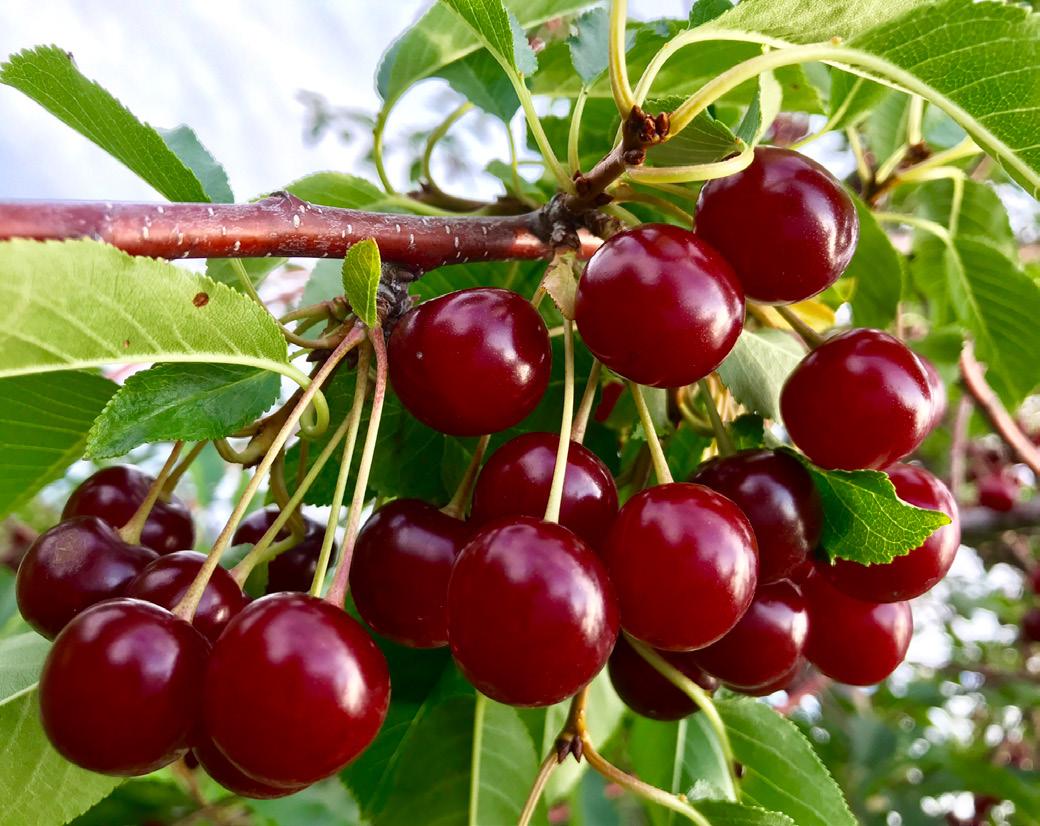


For example, the couple uses Integrated Pest Management (environmental cues and pre-set action thresholds to assess and control pests and diseases responsibly) and non-chemical control strategies to create an environment that discourages pests and diseases. By using IPM, they are able to better manage the overall number of sprays and tractor passes through the vineyard, thereby limiting tractor carbon footprint and soil compaction.
While grape production does require some chemicals in order to produce a healthy crop, the Gales use
Photo courtesy of Island Orchard Cider Photo courtesy of Anchored Roots Vineyard & Wineryinclude spraying kaolin clay on fruit to act as a physical barrier to pests; using drip irrigation to reduce water usage; and hand-picking fruit to avoid using heavy machinery. Meanwhile, Island Orchard also uses leftover or over-fermented cider to make cider vinegar as a zero-waste alternative to dumping imperfect cider. The facility itself also uses a unique geothermal heating and cooling system, significantly reducing energy usage. 12040 Garrett Bay Road, Ellison Bay, 920.854.3344, www.islandorchardcider.com

Lautenbach's Orchard Country Winery & Market - Yet another Travel Green Wisconsin company, Lautenbach’s Orchard Country Winery & Market has been family owned and operated since 1955. Located on 100 acres of blossoming orchards and lush vineyards, Lautenbach’s features a tasting room and a market boasting fresh-baked cherry pies, tart cherry juice, plump dried cherries, wines, hard ciders, and more. Sustainability efforts include reusing and recycling as much as possible, and composting fruit pulp in the juice-, wine- and cider-making process. 9197 WI-42, Fish Creek, 920.868.3479, www.orchardcountry.com
 Photo courtesy of Lautenbach's Orchard Country Winery & Market
Photo courtesy of Lautenbach's Orchard Country Winery & Market
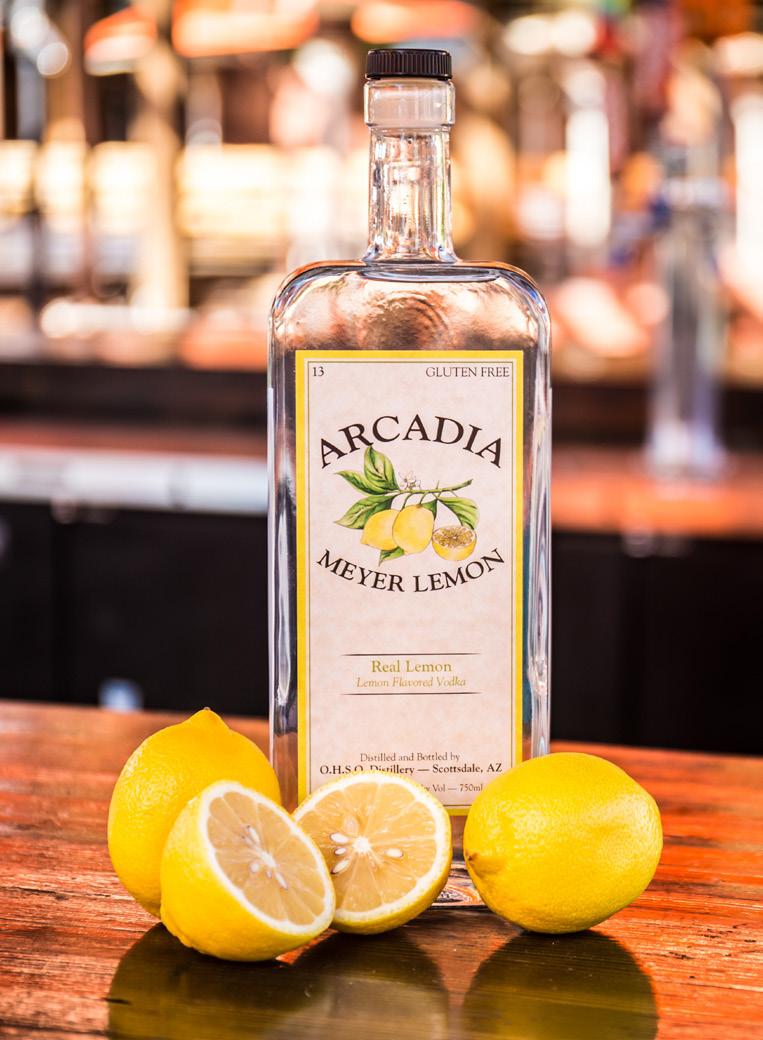 BY ALISON BAILIN BATZ
BY ALISON BAILIN BATZ
WWhile Arizona’s sister to the south is a titan of tequila, and our neighbor to the west is a world leader in wine, State 48 is quickly becoming a mecca for craft distilleries specializing in vodka, gin, rum, whiskey, and more. In fact, according to the Alcohol and Tobacco Tax and Trade Bureau, there are more than 50 registered distilleries or micro-distilleries in Arizona right now.
A favorite of many Phoenicians is O.H.S.O. (Outrageous Home Brewer’s Social Outpost), which opened in Arcadia in 2011. Initially focused on beer, distilling was added to the mix a few years into their success. Today, the North Scottsdale location serves as the headquarters for the distillery operations, including the popular Arcadia Vodka collection (with eight flavored offerings), as well as gin, rum, and whiskey brands. During its tour and tasting package, which costs $35 for two people, guests receive a guided tour, a tasting of four spirits, and one bottle to take home.
SanTan Brewing Company is another beer-making pioneer that quietly expanded into distilling in 2015. Quiet no longer, SanTan opened Spirit House, a craft distillery and tasting room, in 2019 behind its long-time Chandler pub. There are both traditional and experimental offerings in their current line-up, notably bourbon, vodka, and gin, plus bottled cocktails, herbal amaro, coffee liqueur, and brandy. Their whiskies are a particular point of pride for founder Anthony Canecchia. Each varietal is curated between two and four years and is rotated ever-so-slightly at specific time intervals to allow each batch to breathe deep into the wood. This painstaking process is used for the company’s more traditional and cask-strength offerings, as well as its
newer flavor-infused whiskies, including CaraMellow. As the name suggests, there are definite notes of a Cadbury Caramello candy bar. But, unlike the bar there is no chocolate present. Instead, sea salt caramel is combined with a hint of toasted marshmallow and then added together to the freshly distilled whiskey prior to proofing.
The current distillery tour ($15 per person), takes guests behind the scenes, showcasing a 35,000-square-foot working production facility. And yes, there are ample samples along the way.
Rounding out the list of breweries-turned-distilleries is Grand Canyon Brewing + Distillery, offering tours by appointment almost daily at its full distillery operation in Williams, Arizona. The cost varies based on group size, tastings, and optional food pairings, as there is a full scratch kitchen on site. There are additional locations in Flagstaff and Page that also offer extensive tasting flights of both beer and spirits (pro tip: do not miss the Cinnamon Fire whiskey) as well as a full dining menu, though no formal tours are provided. Taking advantage of the canned cocktail craze, Grand Canyon is also using its spirits in several canned products, including vodka-, rum-, and gin-based beverages. The Orange Blossom Vodka Soda is a standout, as much for being completely sugar-free as it is for its bubbly effervescence and sweet and heady flavor.
Certainly, there are also a number of distilleries solely focused on spirits from the jump, starting with Arizona Distilling Company. When Arizona Distilling released Copper City Bourbon in 2013, it became the first legally produced local spirit since before Prohibition. Honored at the 2014 San Francisco World Spirits Competition, Arizona Distilling paved the way for barely burgeoning distillers to follow in its footsteps. Today, the distillery offers regular tours and has its own cocktail bar and kitchen in Tempe.


Also in Tempe are Adventurous Stills and Wild Hare Distillery.
Adventurous Stills got its start in 2015 and proudly uses 70% local grains in its recipes. There are nearly a dozen varietals in its lineup, notably Lost Dutchman Rye Whiskey, Absinthe Minded Verte, and Orange Witsky made with Helluva Brewery Orange Wit Beer. The distillery is open for tastings, tours starting at $14, and hosts a “become a distiller for a day” program.
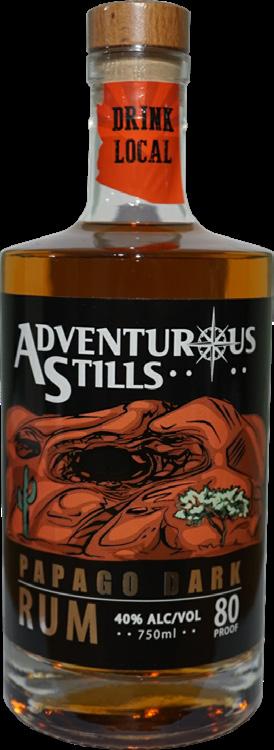
Wild Hare Distillery offers the tasting adventure of a lifetime. Ever tried a toasted Madagascar vanilla-infused agave spirit? You can at this husband-and-wife operation that imports blue agave directly from Tequila, Mexico for its line of agave spirits. They distill small-batch whiskey and vodka, as well. Tours and tastings are available by reservation only.
In Old Town Scottsdale, Blue Clover Distillery is another beauty. The area’s first micro distillery makes its vodka with farm-fresh corn and uses reverse osmosis water for a clean taste. Its gin is also special, given that it is infused with various fruits and plants from the American Southwest, including blood orange, desert rose, and peach — a crop that many may not know grows readily in Arizona. Thanks to floor-to-ceiling glass walls, anyone visiting can see where all the small batch spirits are produced in the distillery room, including its impressive handmade copper stills. While the front-row access to the process is complimentary, private tours and buyouts are available for a fee.

Finally, among the most awarded distilleries at the national level is Whiskey Del Bac. Founded in Tucson by a furniture designer who used mesquite wood in his work to showcase the native Arizona plant, Whiskey Del Bac is made by malting barley over mesquite wood to achieve what the founder calls a “mesquited, not peated” flavor profile. Tours of the popular Southern Arizona distillery, both public and private, are offered several times a week for $35 per person. The 75-minute experience starts with a welcome cocktail followed by a guided tour of the distillery, followed by a comprehensive tasting of the brand’s core products.



 BY: ALISON BAILIN BATZ
BY: ALISON BAILIN BATZ
TThere is a saying that if it grows together, it goes together. In other words, there are direct benefits — freshness, seasonality, authenticity, sense of place — to sourcing local ingredients when crafting a dish. Arizona’s top chefs know this all too well. Here are some of our state’s sensational purveyors, and the restaurants that proudly serve them.
For more than 10 years, Noble Bread has been baking some of the most beloved loaves in the Valley. Each perfectly crafted ode to carbs takes approximately 36 hours to make, using GMO-free flour and an organic leaven starter. There are currently more than 30 types of Noble Bread on the market, with everything from cranberries and walnuts to flax seed and honey inside. Some of the most inspired uses of the bread can be found at The Brickyard Downtown Chandler, Elliott’s Steakhouse, Aftermath Bar & Kitchen, The Sicilian Butcher, Ironwood American Kitchen at Fairmont Scottsdale Princess, The Macintosh, Brix, OEB Breakfast Co., Chula Seafood, Litchfield’s at
The Wigwam, The Coronado, The Gladly, Citizen Public House, The VIG, The Little Woody, Campo Italian Bistro & Bar, The Womack, Fire at Will, and Miracle Mile Deli.
Ramona Farms is a family-owned farm on the Gila River Indian Reservation that grows several crops but is most famous for its tepary beans. Native to the Sonoran Desert, the tepary bean has been grown by Native Americans for thousands of years, and in Arizona for more than a thousand years. Their brown and white varietals are exceptionally popular on Arizona menus, including at The Wrigley Mansion,
L’Auberge de Sedona, The Farm at South Mountain, The Table at Junipine, Valentine, and Wilderness Brewing Co
Two Wash Ranch is a five-acre poultry farm in New River that specializes in chickens, ducks, geese, and even has eggs. The farm is owned by a Midwest transplant who never intended to be a professional in the field — his background is as a mechanic — but over the years has come to be known as the gold standard in poultry. Find his proteins on the menus at FnB, Hearth ’61 at Mountain Shadows, Christopher’s at The Wrigley Mansion, Quiessence, LONS at the Hermosa Inn, Francine, and Tarbell’s, to name a few.
Don’t be deceived by our ample desert, because Arizona is one of the best places to grow a number of fruits and veggies. There are hundreds of working farms, many selling their bounty to local eateries near and far. For example, for four generations, the Duncan family has sustainably farmed over 150 types of fruits and vegetables at its Duncan’s Trading Company in West Phoenix, including more than a dozen varieties of squash, lettuces, and tomatoes; eight varieties of melons; and six varieties of beets of all colors. Visit Binkley’s, Vincent on Camelback, Zuzu at Valley Ho, Elements at Sanctuary, or Hearth ‘61 at Mountain Shadows for seasonal produce offered daily.
McClendon’s Select is another stunner. Located on 25 acres in Peoria with an additional certified organic 68 acres in Goodyear, there are more than 100 varieties of fresh fruits and vegetables growing at any given time. They also produce dates, honey, and bee pollen. They are a farmer’s market staple and proudly served on the menus at Campo Italian, The Genuine, FnB, Binkley’s, and Craft 64.
Since 1944, Hickman’s Family Farms has grown from an operation of just a few hens to the largest egg producer in the Southwest. Locally owned by the Hickman family since its initial founding in Glendale, today the farm has over 4 million hens living cagefree on property and is a member of the American Humane Certified program, which ensures the birds are raised humanely while being protected from predators. Hickman’s eggs are always on the menu at Vecina, Camelback Inn, U.S. Egg, Hash Kitchen, The Sicilian Butcher, The Sicilian Baker, Ocotillo,
and many more. In fact, as twisted takes on deviled eggs continue to be all the rage in the Valley, there are several hotspots that dream up themed eggs several times a week, notably Merc Bar and Beckett’s Table, which has riffed on the traditional recipe by adding everything from pickled mushrooms to peanut butter over the years.
Crow’s Dairy, located in West Phoenix, is a fifthgeneration family dairy that was once best-known for its cow milk. But in 2008 they made the move to start raising Nubian dairy goats. Though they started with just 25, the results were impressive: they currently raise and milk over 300 goats in order to fulfill their hundreds of orders for goat-based milk and cheese products statewide.
Also family owned and operated and located in West Phoenix is Danzeisen Dairy, where each of the heifers is kept happy thanks to monthly visits from a cow nutritionist who monitors the ladies’ diets and feed quality. The resulting hormone-free products range from whole, skim, and reduced fat milks, as well as creamer and naturally flavored milks, including one that tastes like a creamsicle. All items come in glass bottles to preserve freshness. There is also a line of juices – currently lemon, orange, and strawberry lemon – made using Purely Sedona Artesian Spring Water. You can find one or both dairies in several dishes all over town, including at Café Monarch, Crujiente Tacos, Ironwood American Kitchen at the Fairmont Scottsdale Princess, Merkin Vineyards Scottsdale, Larder + the Delta, Southern Rail, Maple & Ash, Scramble, Cielo at ADERO Scottsdale, LON’s at the Hermosa Inn, The VIG, The Genuine, Campo Italian, and Luna Gelateria
Deep in the Southeast Valley is Queen Creek Olive Oil Company, Arizona’s only working olive farm and mill. Located on a whopping 100-acre farm and with more than 7,000 olive trees, Queen Creek Olive Mill produces dozens of olive oils, balsamic vinegars, tapenades, sauces and – of course – olives. Visiting the mill is a treat, but it’s possible to taste many of its products in town at Proper Meat + Provisions, Fat Ox, The Mission, ZuZu Gertrude’s, and Crujiente Tacos. There is also an Oils & Olives by Queen Creek Olive Oil Mill retail shop located at Kierland Commons in Scottsdale with hundreds of products from which to choose.
COURTESY OF THE ITALIAN DAUGHTER
Ingredients
5 to 6 cloves of garlic
½ cup olive oil
24 ounces heirloom cherry tomatoes
½ cup chicken stock
½ cup chopped fresh basil
Grated Parmesan cheese
Salt & pepper to taste
10 ounces dry pasta, prepared and drained
Directions
Heat a saucepan on medium heat and add oil and garlic to the pan. Once garlic begins to soften, add the tomatoes, salt and pepper. Cook the tomatoes until the natural juices and olive oil reduce slightly and add chicken stock. Reduce liquid again by half, remove your pan from heat and stir in basil.
Add your prepared and drained pasta to the pan and mix together, adding pasta water if needed to emulsify your sauce. Plate and garnish with more basil and shaved Parmesan cheese.

We can get down with this jam! It’s easy to make and adds incredible flavor to crackers, sandwiches, pasta and meat dishes.

Ingredients
4 large heads of garlic, roasted
1/2 cup Queen Creek Olive Mill Roasted Garlic Olive Oil
1/4 red onion finely diced
1 teaspoon fresh lemon juice
1/4 teaspoon dry rosemary
1/4 teaspoon dry parsley
1/4 teaspoon dry oregano
Salt to taste
Directions
Remove the garlic from the bulb and squeeze the softened garlic cloves into a medium bowl. Add the olive oil and diced onion to the garlic cloves and mash with a fork until smooth. Stir the lemon juice into the mashed garlic and continue stirring until smooth and creamy. Add seasonings and salt.
Place in the refrigerator for two hours before serving to let the herbs infuse into the jam. The garlic jam will keep refrigerated in a sealed container for up to two weeks.
TThe farm-to-table movement began in the late decades of the 20th century. Its goal was to bring diners closer to the food they eat by having restaurants source produce and proteins from local farms. Luxury resorts on expansive swathes of agricultural land, such as Tennessee’s Blackberry Farm, took the concept a step further by growing produce on-site, ensuring that their culinary venues offered the freshest and highest-quality organic food available.
When Arizona’s swanky Castle Hot Springs resort reopened in 2019 after more than 40 years of disuse, its farm program quickly garnered as much attention as its natural pools of therapeutic mineral-rich thermal water (to learn more about the health benefits of hot springs, see our May 2023 story “Taking the Waters”). The landmark lodging cradled in the foothills of the Bradshaw Mountains about 50 miles north of downtown Phoenix is a verdant oasis tucked into the rocky terrain.

Agronomist Ian Beger has been with the resort since the start of its restoration. Prior to joining the team at Castle Hot Springs, Beger had built a reputation for growing and providing high-end restaurants with specialized vegetables as the owner of Scottsdale’s Brother Nature Farms. As the resort’s farm manager, he helped design and implement the property’s agricultural program.
Initially, the resort had a single garden — a fan-shaped
planting area that stretched out from the southwest corner of the main lodge, a canary-yellow structure that houses the property’s restaurant, Harvest, and lounge, Bar 1896. Known as the culinary garden, it provided kitchen staff with instant access to ingredients such as herbs, microgreens, and edible flowers.
“We realized after the first year that we wanted to provide more of the substance of the food — the carrots, the cauliflower, broccoli — but we really couldn’t provide most of that from this space,” Beger says.
With the addition of a one-acre vegetable garden, multiple high tunnel greenhouses, and a large glass greenhouse in which Beger and farm operations manager David Bullock grow and breed tomatoes — along with a three-acre agave farm, a quarter-acre of stone fruit trees, and a citrus orchard — Castle Hot Springs now offers five acres of cultivable space.
“Our main goal is to provide the best quality fruits, vegetables, and herbs to the kitchen, the bar and, ultimately, our guests. And we’re trying to do that in a sustainable and delicious way,” Beger says. “We’re focused on flavor more than anything else.”
Gardening in the Sonoran Desert can be challenging due to the region’s extreme heat, low humidity, and poor soil quality. The landscape at Castle Hot Springs also offers additional characteristics that must be taken into consideration.

“We have very unique growing conditions. It’s unlike anywhere else that I’ve ever grown before,” Beger explains. The main water source is the property’s spring water, which has a high mineral content. The water infuses the crops with a distinctive minerality and flavor.
The farm team takes what Beger calls “a shotgun approach” to agriculture. “We try out as many varieties as we can, see what works and what doesn’t, and then double down on the ones that are growing well,” he says. “We’re a pretty experimental farm.”
To find produce that thrives in the desert — and that brings robust flavors to the plate — the farmers have trialed more than 1,000 varieties. Each year, about 30
percent of the crops sowed are new. Typically, new crops comprise only about 10% of a traditional farm’s annual production.
In addition to growing Southwest garden staples, such as cucumbers, onions, strawberries, asparagus, and a variety of peppers, Beger and his team cultivate some unusual varieties of produce.
One of the most popular is mokum carrots. Small in size and sweet in flavor, they store longer than other varieties.
“It’s the best carrot you’ll ever have,” says Castle Hot Springs Executive Chef John Amman, who uses the root vegetable to create the popular mokum carrot soup. “We include some of our citrus, lime leaves, coconut milk, fresh ginger, and herbs, such as Texas tarragon or Mexican oregano. And because we use the mokum carrots, we don’t need to add a sweetener to it. The carrots are as sweet as candy, and that makes a substantial impression on the dish. People come back just for the mokum carrot soup.”
For the past five years, Beger and Bullock have been growing and breeding tomatoes. At one point, they were cultivating about 45 different kinds. Currently, the greenhouse holds about 15 varieties, from large heirlooms to petite, juicy cherries.
The pair uses a production method called “highwire,” in which vines are trellised upward on wires. This system allows the plants to grow continuously
throughout the year and produces an enormous amount of tomatoes in a relatively small space.
“It’s the highest yield per square foot way of growing tomatoes,” Beger notes. “It’s easy to harvest, but it’s also quite a bit of work. We’re also doing some of our own tomato breeding,” he continues.
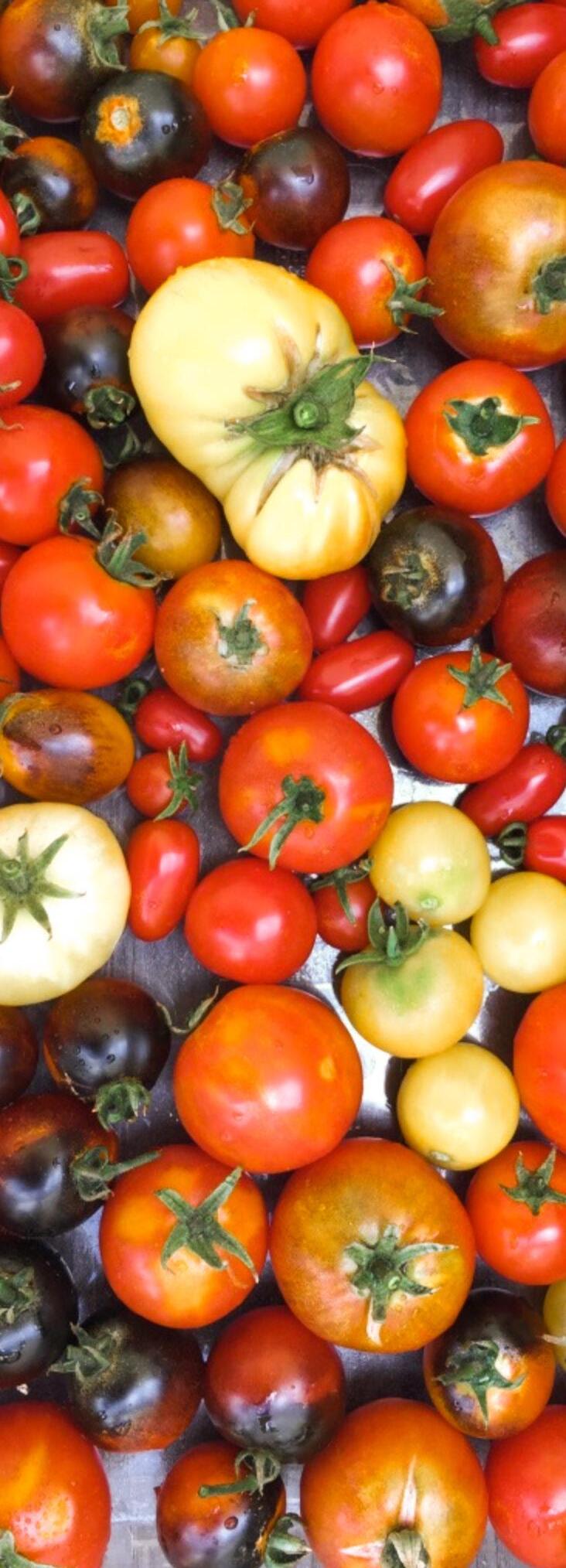
Bullock has been working with a cross between the Paul Robeson, a beefsteak variety that’s known as one of the best-tasting tomatoes in the world, and his personal favorite, the Green Doctor, a light green heirloom cherry tomato. Beger hopes his own creation, a cross between the two-tone Lucid Gem and the striped Tigerella that he’s named the Lucid Tiger, will one day become an heirloom variety that’s exclusive to the resort.
More than 150 varieties of fruits – including dozens of types of heirloom tomatoes – vegetables, herbs, and edible flowers are harvested each season at Castle Hot Springs. Here are some of the property’s more unusual offerings:
Blue spice basil (Ocimum basilicum): A key ingredient in Castle Hot Springs’ welcome tea, it features fragrant purple spikes that are covered in lavender flowers. The leaves and flowers taste like bubblegum.
Bronze fennel (Foeniculum vulgare dulce): This aromatic flowering perennial features edible licoriceflavored leaves and seeds. Its yellow flowers attract pollinators.
Dragon tongue (Phaseolus vulgaris): The purple pods of this garden-friendly snap bean can grow as long as eight inches. They’re rich in protein, vitamins, and antioxidants.
Dulce button (Phyla dulcis): An herbaceous plant that’s part of the mint family. Its tiny white flowers are incredibly sweet — up to 1,500 times sweeter than conventional sugar. It’s ideal for use in cocktails.
Epazote (Dysphania ambrosioides): An aromatic leafy herb with edible leaves and stems. It is commonly used to flavor beans.
French sorrel (Rumex scutatus): This leafy herb looks like spinach but has a taste similar to sour green apple.
“That’s the great thing about having a place like this. Not only is the water here unique, but you have these varieties of tomatoes that you’re never going to get elsewhere,” Bullock says. “It’s exciting.”
At any given time, there are more than 150 varieties of fruits and vegetables in the ground. Produce that’s not consumed immediately is pickled, cured, or fermented, preserving the flavors for out-of-season use. Herbs and flowers are dried for use in teas and simple syrups.
“We’ve done a lot of experimenting in the past five years. Now it’s time to start homing in on those staple varieties,” Beger says, noting that he would like the gardens to eventually provide 80 percent of the produce used by the kitchen. “We’re still going to experiment. That’s something we never want to get away from, but we’ll probably do small batches. Because our goal is to grow the highest-quality vegetables that we can. And sometimes, in order to do that, you need to hunt it down.”
For more information about Castle Hot Springs and its farm program, visit www.castlehotsprings.com
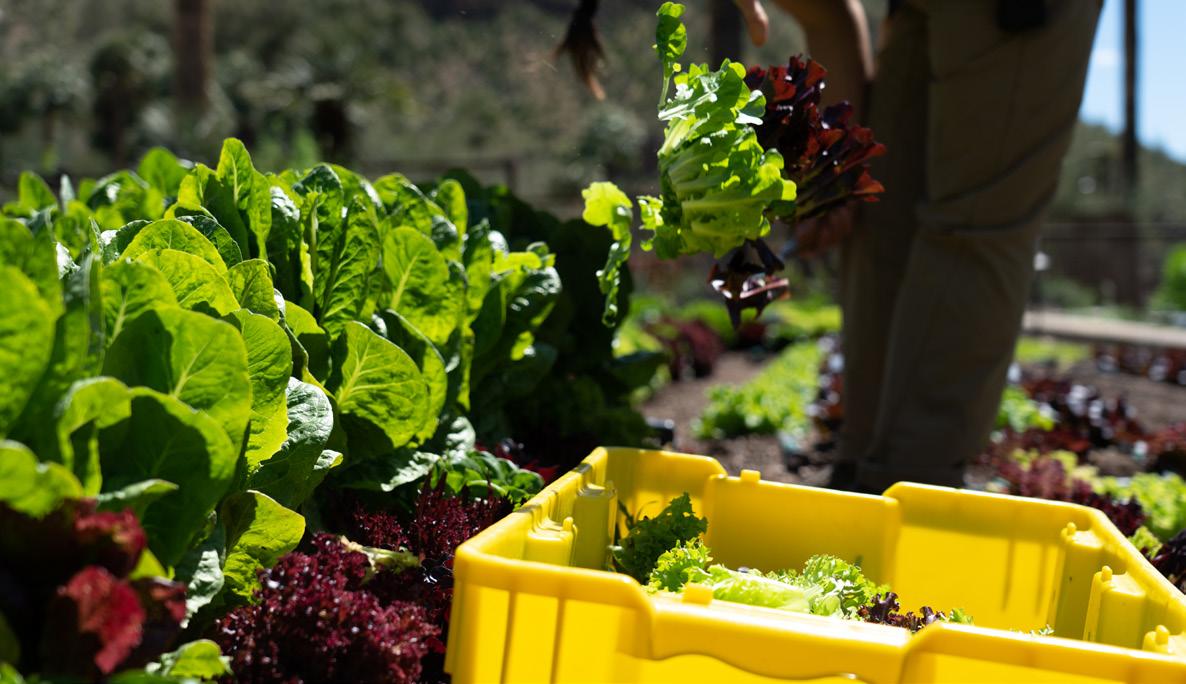
Glacier lettuce (Mesembryanthemum crystallinum): This edible succulent takes in salt from the water and soil, resulting in a flavor that’s reminiscent of the ocean.
Moringa (Moringa oleifera): A fast-growing, droughtresistant tree. Its leaves and pods are considered a superfood that can benefit everything from skin conditions to high blood pressure to infections.
Sea beans (Salicornia): The flowering succulents with branch-like stalks add a salty crunch to soups and salads. The chefs at Castle Hot Springs also add it to the Green Goddess dressing.
Sonoran passionfruit (Passiflora arizonica): The distinctive purple-blue flowers with pale yellow stamens contain mouthwatering edible pulp.
Texas tarragon (Tagetes lucida): Unlike its French cousin, this perennial grows well in the desert heat. Its flavor and aroma are similar to sweet black licorice.
Variegated Pink Eureka lemon (Citrus limon ‘Variegated Pink Eureka’): This citrus tree with variegated leaves flowers multiple times a year. It produces yellow fruit with green stripes and pink flesh.







As we become more attune to the negative effects of methane gas produced by dairy farms around the globe, technology to capture methane gas and convert it into a useful byproduct is becoming more imperative. Methane is second only to CO2 emissions from fossil fuels as a cause of global warming. Southwest Gas, along with partners like Nacelle Solutions, Avolta Development, and DVO, are working together with eco-conscious dairy farmers across Arizona to reduce greenhouse gas emissions and produce renewable natural gas for use in households, vehicles, and more.
Its latest project with Butterfield Dairy in Buckeye, Arizona, is working to capture the methane from dairy manure produced by more than 25,000 cows and convert it into over 300,000 MMBtu of renewable natural gas (RNG) annually. This is the equivalent of eliminating emissions from more than 3,600 cars — and it can power 2,925 households each year. As part of a sustainable and balanced energy future, RNG is one of the most promising new energy supplies — a sustainable low-carbon fuel produced by safely capturing, cleaning, and upgrading biogas produced from various sources, including animal waste, wastewater treatment facilities, and landfills.

At Butterfield Dairy, an anaerobic digester from DVO is used to convert the manure — composed mainly of methane and carbon dioxide — into biogas. The mixture is then upgraded to pipeline-quality natural gas using equipment from Nacelle Solutions.
“Nacelle’s upgrading equipment utilizes a variety of technologies to safely remove hydrogen sulfide, carbon dioxide, and other contaminants from the biogas to create renewable natural gas that meets pipeline specifications for quality and safety,” said Kim Sachise, director of marketing for Nacelle Solutions.
Following the upgrading process, RNG can be delivered through existing natural gas pipelines and is compatible with existing natural gas appliances, industrial equipment, and compressed natural gas vehicles without any modifications. This means end-users do not need to change their natural gas equipment to use RNG.
Southwest Gas partnered on the Butterfield Dairy project to build the interconnection that allows RNG from the farm to be piped directly into the Southwest Gas distribution system and available to the market, helping businesses, communities and
the transportation industry meet their respective emissions reduction goals.

“We continually strive to exceed our customers’ expectations by safely delivering reliable and sustainable energy which helps to preserve our natural resources, contribute to energy diversity, and foster economic development and growth in our communities,” said Dr. Laura Nelson, Southwest Gas vice president of sustainability and public policy. “Innovative energy solutions, like RNG, help communities move towards their decarbonization goals.”

Butterfield Dairy is owned and operated by the de Jong family, whose history of farming can be traced back to Holland nearly four centuries ago.
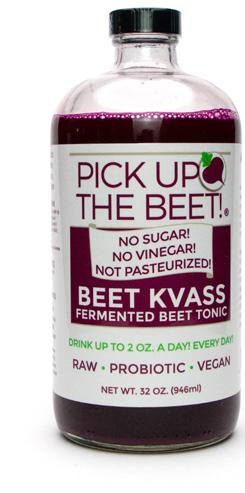
“The dairy industry has seen a lot of change since our family started in the 1620s,” says Butterfield Dairy owner Tommy de Jong. “These RNG developments will not only help us to continue to care for our animals but will provide clean energy for generations to come.”

The Butterfield Dairy RNG project was developed by Avolta Development, a renewable energy company focused on originating and developing RNG projects. It began delivering gas into a Southwest Gas pipeline in the first quarter of 2023. In addition to upgrading the biogas to RNG, Nacelle Solutions operates and maintains the entire project, including the digester and upgrading equipment, as well as manure management.
To date, Southwest Gas has constructed interconnections with five RNG projects in Arizona and California to transport pipeline-quality RNG to the market, with an anticipated production of over 13-million therms of RNG.
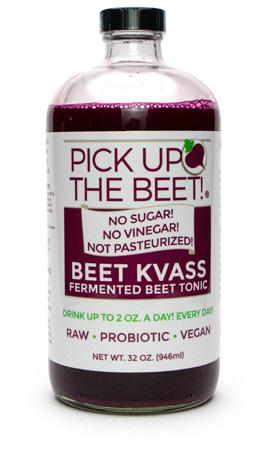

If you're asking yourself, “Self, what else can I do to help the planet?”, have you looked at your beverage choices lately? It feels like this could be an often overlooked opportunity for us as individuals make a collective impact. Sure, looking for the obvious keyword of “organic” on the label is a great start, but how about looking even further into a company's business practices? Are they using renewable energy? Conserving water? Including local ingredients in their recipes? Buying bamboo toilet paper? Not kidding, we looked! We checked out many other things too about Hopworks - a brewery with locations in Portland, Oregon and Vancouver, Washington that is BIG on doing right by the planet.
She Said: In the area where we live, it wasn't hard to find a local brewery. I bet it isn't difficult these days no matter where you live - just look in your own backyard. Maybe literally. Hops are easy to grow, right? Since WE didn't have any hops, off to the brewpub we went. I noticed right away that “reduce, reuse, and recycle” was taken seriously at Hopworks, with lampshades made from modified growler jugs, and tables from reclaimed wood or repurposed doors. But how about the beer? Oh, they didn't disappoint! There was a fun variety of brews made on-site (with organic hops, I might add), from IPAs to “Patagonia,” which is important to point out because its made from a special type of grain, Kerzna, that prevents soil erosion, uses less water, and thrives without pesticides. What?! Talk about creative ways to help our environment and get your drink on! They also had a tasty cider that was a perfect balance of sweet, tart, and dry. The menu was recently updated, with reliable dishes of burgers, salads, fries, and apps. The staff was also very apt to accommodate my fussy order of a bacon and blue cheeseburger with no cheese and a gluten-free bun (which was still great). The pretzel twists with beer cheese appetizer though? Wow! Honestly, I'd go back just for the pretzels and a pint of the mahogany-hued “Velvet ESB.” Mmmm! But I'd also go back to support the awesome things this company is up to, like using local and organic ingredients, designing efficient buildings, offsetting carbon emissions, using half as much water as other breweries per gallon of beer, earning B Corp and Salmon-Safe certifications, and a ton more. These guys set the bar pretty high for a sustainable business, and thank goodness for that!
He Said: Here we go again my awful job is forcing me to drink beer and hang out in interesting places. Are you picking up my sarcasm? Because I'm laying it on pretty thick. I practically skipped with glee down to our local brewpub, Hopworks. We picked this particular brewery because it has an extensive list of sustainable practices and some pretty tasty beer to boot. They source most of their ingredients locally, use organic malt in every single brew, and four out of the five beers I tried had the green badge of honor. That's right, nearly every delectable beverage on my sampler plate was USDA organic. I started my flight with the light, citrusy, West Coast IPA, “Gear Up,” then moved on to the malty, sweet, “Patagonia” northern ale made from Kernza root (which is an amazing grain, look it up). I believe it was about this time that my beer cheese pretzel and green chili burger arrived. I washed those down with a heavenly, smooth red ale, “Velvet ESB.” Dessert was a caramel, roasty, “Beestly” honey porter. Mmm-mmm! Now, you know I try to be very thorough with my reviews, but if you feel this one wasn't good enough please email my editor and tell her to force us to do this one over again. Don't worry, you won't hurt my feelings.





Learn how to reduce your kitchen waste by composting at home with worms. This class, which takes place at 10 a.m. at Dig It Gardens in midtown Phoenix, will teach you everything you know to get started — from creating a worm bin to understanding the difference between browns and greens. Tickets are $20. Visit www.letsgocompost.org/events to purchase.


It’s the most edible time of the year as everyone’s favorite foodie festival returns with 10 days of culinary exploration. The 2023 Fall Arizona Restaurant Week welcomes diners to discover the breadth of food and beverage options available throughout the Valley with special three-course prix-fixe menus at more than 150 restaurants. Sponsored by the Arizona Restaurant Association. For more information, including a list of participating restaurants and menu prices, visit www.arizonarestaurantweek.com.
Park West presents its inaugural Eat For Education fundraiser benefiting the Peoria Education Foundation. The event takes place at participating restaurants and retailers throughout the center from 4-9 p.m. on Tuesday, Sept. 19. During the event, when guests make a purchase at a participating restaurant or retailer, a portion of the proceeds will be donated to the Peoria Education Foundation to support the Peoria Unified School District. For more information, visit www.shopparkwest.com.
September 21
Yappy Hour
Enjoy an evening of fun with Fido while supporting a great cause at this happy hour designed with your pup in mind. Head to the District Stage at Desert Ridge Marketplace from 6-7:30 p.m., where you’ll find fun games, giveaways, doggie treats and people eats, photo ops and even adoptable puppies. The event is free, but donations to support the Arizona Humane Society are encouraged. RSVP at www.shopdesertridge.com/event/yappyhour/.
September 23
Have you ever come across olive trees in Phoenix and wanted to learn how the small green stone fruits are processed? Then head over to the urban farm at Sage Garden Ecovillas in Mesa for a demonstration on how to harvest, prepare and cure olives. The free two-hour class takes place Saturday and Sunday from 9-11 a.m. Questions? Visit www.sagegardenecovillas.com.
Celebrate Mexican cuisine and culture at this delicious familyfriendly event at Dr. A.J. Chandler Park. More than 20 local restaurants will be dishing up South of the Border fare from noon - 9 p.m. Sample tasty tacos, enjoy music from a Red Hot Chili Peppers tribute band, cheer on lucha libre wrestlers and test your taco mettle on the mechanical Rockin’ Taco ride. For more information and tickets, visit www.forty8live.com/rockintacoaz/.
September
Liberty Wildlife treats and rehabilitates more than 12,000 birds and mammals each year. Those that can’t be released often find homes in the group’s educational programs. On this train ride, you’ll get to meet some of these special raptors, including Aurora, a 20-year-old bald eagle. Get up close with the birds at the train depot in Clarkdale for free from 11 a.m-12:45 p.m., then take a ride with them on the Verde Canyon Railroad. Train tickets are $109-$119. Go to www.verdecanyonrr.com.

September 8-17
Sonoran Restaurant Week

Tucson’s own Sonoran Restaurant Week celebrates the Old Pueblo’s unique culinary heritage and its UNESCO City of Gastronomy designation. Enjoy incredible three-course meals at participating locally owned City of Gastronomy Certified restaurants that support heritage food conservation, sustainable practices and economic development. For a complete list of restaurants, visit www.sonoranrestaurantweek.com.
September 15-17
21st Annual Roasted Chile Festival
Things are heating up in Tucson as the city welcomes chile season. Challenge your taste buds with some of Arizona’s hottest chiles along with Southwest favorite Hatch chiles straight from Hatch, New Mexico. Live music, local vendors, kids activities and fresh roasted chiles can be found at three farmer’s market locations over the weekend. Admission is free. Learn more at www.heirloomfm.org.

Experience a meal unlike any other as you dine under the stars amongst Sedona’s stunning red rock landscape. Set atop one of northern Arizona’s breathtaking mesas, your meal will include a five-course menu of fresh, seasonal local ingredients with an optional wine pairing — all as you overlook the incredible vistas of Capitol Butte and the Red Rock Secret Mountain Wilderness. Tickets are $175 per person. For details about the menu and to purchase tickets, visit www.clothandflame.com.
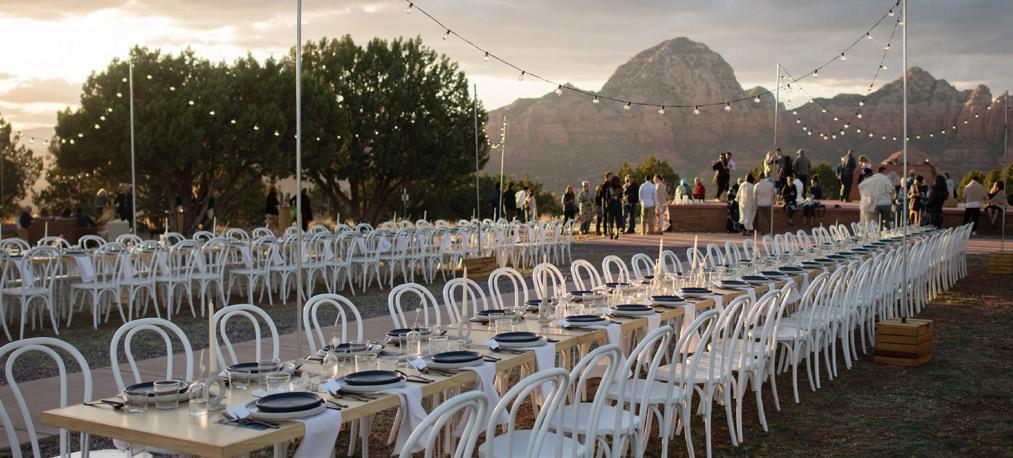
Discover the healing uses of many unique plants that are native to the Southwestern U.S. and northern Mexico. Located on the campus of the Museum of Northern Arizona, the garden showcases low-water-use fauna that are key to remedies of the past and contemporary herbalism. The free tour begins at 10 a.m. For more information, visit www.musnaz.org.
September 16
17th Annual Fur Ball
Shelter pets are the belles of the ball at the Humane Society of Yuma’s annual fundraiser. This year’s theme is “Top Hats and Tails,” so come in your best finery and enjoy an evening of fine dining, live entertainment and auctions to benefit a worthy cause. The event kicks off at the AWC Schoening Center at 6 p.m. Tickets are available at www.hsoyuma.com/ event-fur-ball.html.

Investors have survived market swings and corrections before. But a twinge of uncertainty may have you wondering if you should get another opinion to help confirm your wealth is in the right place. That’s why we’ve made it as easy as we can to have a complimentary, face-to-face meeting with an advisor.
18700 N. Hayden Road Suite 525 Scottsdale , AZ 85255
Direct: (480) 419-2016
mark.morales@wellsfargoadvisors.com
https://home.wellsfargoadvisors.com/mark.morales CA Insurance # 0D34255

©2022

Presented by:

October 21
9AM to 2PM
McDowell Mountain Ranch Park

10607 E. Paradise Lane, Scottsdale, AZ. 85260
Rock Climbing Wall

Arizona Sport Teams

Inflatables

Tug of War
Hula Hoop Contests


DJ / Entertainment

Face Painting
And, so much more!
Thank You Event Supporters:

Educational Interactive Booths & Giveaways for Everyone




DOWNLOAD YOUR FREE FLAGSTAFF TRAILS PASSPORT AND EARN PRIZES which can include a donation in your name made by Discover Flagstaff providing trail maintenance for future enjoyment.

• Be aware and knowledgeable of fire restrictions.
• Smoking and use of electronic cigarettes are prohibited in all public places within the city of Flagstaff.
• Check for dragging chains or tow straps as they could spark a wildfire.
• Avoid parking in grassy areas where a hot muffler may spark a wildfire.
• Only use designated open forest roads and trails for recreation.
FOR ADDITIONAL INFORMATION:
• Coconino National Forest (U.S. Forest Service) Information: coconinonationalforest.us
• Coconino County Information: coconino.az.gov
• City Fire Restrictions Stages Information: flagstaff.az.gov